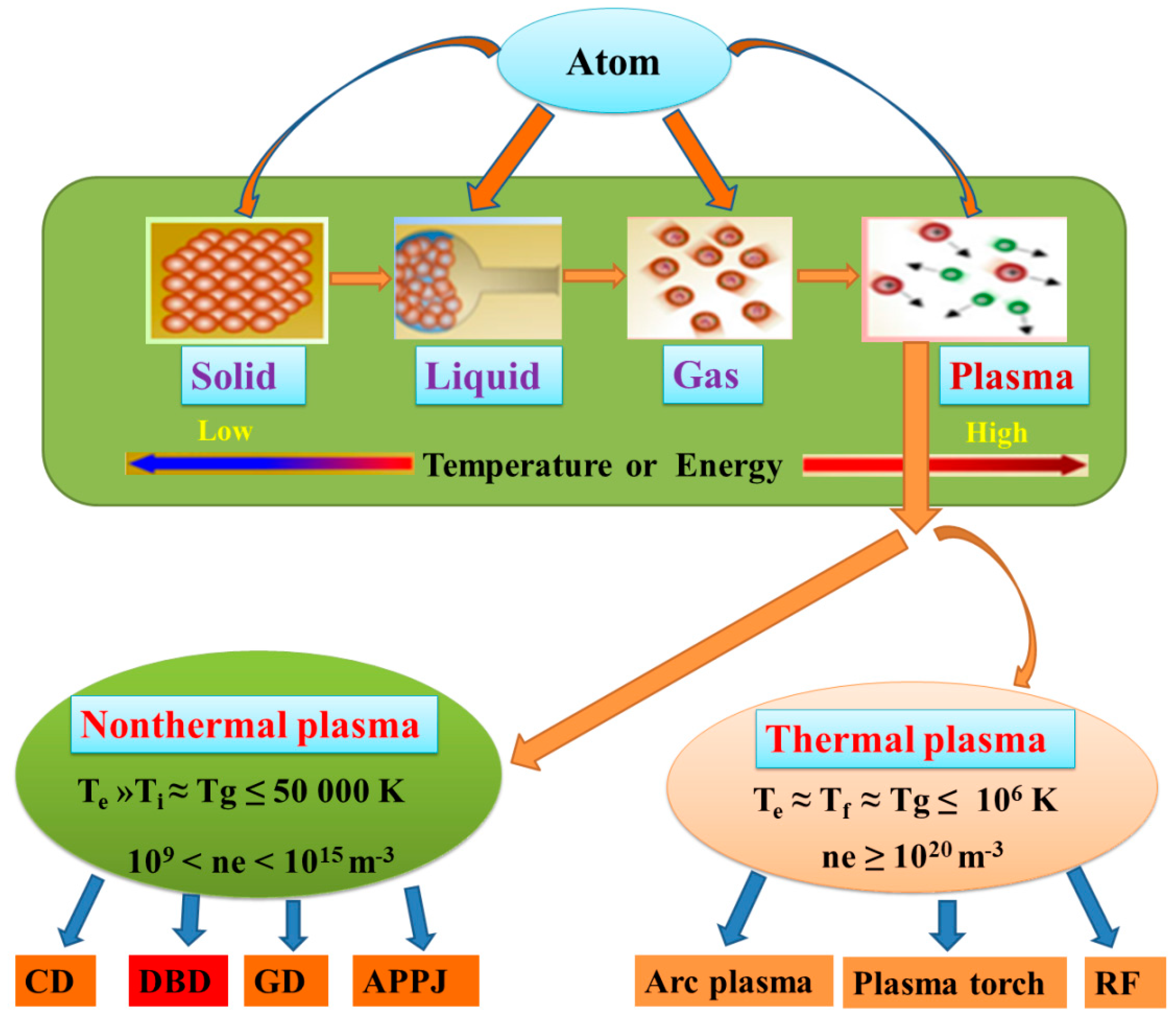Removal of Pharmaceutical Residues from Water and Wastewater Using Dielectric Barrier Discharge Methods—A Review
Abstract
1. Introduction
2. Pharmaceutical Residues in Water and Wastewater
2.1. Types of Pharmaceutical Remains in Water and Wastewater Sources
2.2. Effect of Pharmaceutical Substances in Aquatic Environments on Health
3. Overview of the Plasma Process
3.1. Thermal Plasma
3.2. Non-Thermal Plasma
3.2.1. Dielectric Barrier Discharge: General Description
3.2.2. Summary of the Dielectric Barrier Discharge Operational Scheme
3.2.3. Degradation of Pharmaceuticals by DBD Configurations
Double Cylindrical Dielectric Barrier Discharge System—Formation of the Free Active Species in Different Regions
- Region (a)
- Region (b)
- Region (c) and (d)
- Region (h)
- Region (e)
- Regions (f) and (g)
DBD Driven Excilamps as a Possible Candidate to Decompose Pharmaceutical Compounds
3.2.4. Summary of the Degradation of Pharmaceutical Compounds by DBDs
4. Conclusions
Author Contributions
Funding
Institutional Review Board Statement
Informed Consent Statement
Data Availability Statement
Acknowledgments
Conflicts of Interest
References
- Dos Santos, D.M.; Buruaem, L.; Gonçalves, R.M.; Williams, M.; Abessa, D.M.S.; Kookana, R.; de Marchi, M.R.R. Multiresidue determination and predicted risk assessment of contaminants of emerging concern in marine sediments from the vicinities of submarine sewage outfalls. Mar. Pollut. Bull. 2018, 129, 299–307. [Google Scholar] [CrossRef] [PubMed]
- Edwards, Q.A.; Sultana, T.; Kulikov, S.M.; Garner-O’Neale, L.D.; Yargeau, V.; Metcalfe, C.D. Contaminants of Emerging Concern in Wastewaters in Barbados, West Indies. Bull. Environ. Contam. Toxicol. 2018, 101, 1–6. [Google Scholar] [CrossRef] [PubMed]
- Fairbairn, D.J.; Elliott, S.M.; Kiesling, R.L.; Schoenfuss, H.L.; Ferrey, M.L.; Westerhoff, B.M. Contaminants of emerging concern in urban stormwater: Spatiotemporal patterns and removal by iron-enhanced sand filters (IESFs). Water Res. 2018, 145, 332–345. [Google Scholar] [CrossRef] [PubMed]
- Luo, Y.; Yang, Y.; Lin, Y.; Tian, Y.; Wu, L.; Yang, L.; Hou, X.; Zheng, C. Low-Temperature and Atmospheric Pressure Sample Digestion Using Dielectric Barrier Discharge. Anal. Chem. 2018, 90, 1547–1553. [Google Scholar] [CrossRef] [PubMed]
- Sophia, A.C.; Lima, E.C. Removal of emerging contaminants from the environment by adsorption. Ecotoxicol. Environ. Saf. 2018, 150, 1–17. [Google Scholar] [CrossRef] [PubMed]
- Tran, N.H.; Reinhard, M.; Gin, K.Y.-H. Occurrence and fate of emerging contaminants in municipal wastewater treatment plants from different geographical regions-a review. Water Res. 2018, 133, 182–207. [Google Scholar] [CrossRef]
- Pharmaceuticals in Drinking Water: Public Health and Environment: Water, Sanitation, Hygiene and Health. WHO/HSE/WSH/11.05. Available online: https://www.who.int/water_sanitation_health/publications/2011/pharmaceuticals_20110601.pdf (accessed on 1 June 2011).
- Grube, A.; Donaldson, D.; Kiely, T.A.; Wu, L. Pesticides Industry Sales and Usage: 2006 and 2007 Market. Estimates; United States Environmental Protection Agency: Washington, DC, USA, 2011; p. 41.
- Tijani, J.O.; Fatoba, O.O.; Petrik, L.F. A review of pharmaceuticals and endocrine-disrupting compounds: Sources, effects, removal, and detections. Water Air Soil Pollut. 2013, 224, 1770. [Google Scholar] [CrossRef]
- Li, Y.; Yi, R.; Yi, C.; Zhou, B.; Wang, H. Research on the degradation mechanism of pyridine in drinking water by dielectric barrier discharge. J. Environ. Sci. 2017, 53, 238–247. [Google Scholar] [CrossRef]
- Luo, X.C.; Guo, Y.; Ngo, W.; Nghiem, H.H.; Hai, L.D.; Zhang, F.I.; Liang, J.; Wang, S. A review on the occurrence of micropollutants in the aquatic Environment and their fate and removal during wastewater treatment. Sci. Total Environ. 2014, 473–474, 619–641. [Google Scholar] [CrossRef]
- Roh, H.; Subramanya, N.; Zhao, F.; Yu, C.P.; Sandt, J.; Chu, K.H. Biodegradation potential of wastewater micropollutants by ammonia-oxidizing bacteria. Chemosphere 2009, 77, 1084–1089. [Google Scholar] [CrossRef]
- World Health Statisitics. 2011. Available online: https://www.who.int/gho/publications/world_health_statistics/EN_WHS2011_Full.pdf (accessed on 14 January 2011).
- Zimmermann, S.G. Enhanced Wastewater Treatment by Ozone and Ferrate: Kinetics, Transformation Products and Full-Scale Ozonation. Ph.D. Thesis, ETH Zurich, Zurich, Switzerland, 2011. Available online: https://www.research-collection.ethz.ch/bitstream/handle/20.500.11850/152880/eth-4295-02.pdf (accessed on 14 January 2011). [CrossRef]
- Mulbry, W.; Kondrad, S.; Pizarro, C.; Kebede-Westhead, E. Treatment of dairy manure effluent using freshwater algae: Algal productivity and recovery of manure nutrients using pilot-scale algal turf scrubbers. Bioresour. Technol. 2008, 99, 8137–8142. [Google Scholar] [CrossRef] [PubMed]
- Frisbie, S.H.; Mitchell, E.J.; Dustin, H.; Maynard, D.M.; Sarkar, B. World health organization discontinues its drinking-water guideline for manganese. Environ. Health Perspect. 2012, 120, 775–778. [Google Scholar] [CrossRef] [PubMed]
- Gultekin, I.; Ince, N.H. Synthetic endocrine disruptors in the environment and water remediation by advanced oxidation process. J. Environ. Manag. 2009, 85, 816–832. [Google Scholar] [CrossRef] [PubMed]
- Kasprzyk-Hordern, B.; Dinsdale, R.M.; Guwy, A.J. The removal of pharmaceuticals, personal care products, endocrine disruptors and illicit drugs during wastewater treatment and its impact on the quality of receiving waters. Water Res. 2009, 43, 363–380. [Google Scholar] [CrossRef]
- Maletz, S.; Floehr, T.; Beier, S.; Klumper, C.; Brouwer, A.; Behnisch, P.; Higley, E.; Giesy, J.P.; Hecker, M.; Gebhardt, W.; et al. In vitro characterization of the effectiveness of enhanced sewage treatment processes to eliminate endocrine activity of hospital effluents. Water Res. 2013, 47, 1545–1557. [Google Scholar] [CrossRef]
- Mouele, E.S.M.; Tijani, O.J.; Fatoba, O.O.; Petrik, L.F. Degradation of organic pollutants and microorganisms from wastewater using different dielectric barrier discharge configurations—A critical review. Environ. Sci. Pollut. Res. 2015, 22, 18345–18362. [Google Scholar] [CrossRef]
- Brown, R.K.; Harnisch, F.; Wirth, S.; Wahlandt, H.; Dockhorn, T.; Dichtl, N.; Schroder, U. Evaluating the effects of scaling up on the performance of bioelectrochemical systems using a technical scale microbial electrolysis cell. Bioresour. Technol. 2014, 163, 206–213. [Google Scholar] [CrossRef]
- Heidrich, E.S.; Edwards, S.R.; Dolfing, J.; Cotterill, S.E.; Curtis, T.P. Performance of a pilot scale microbial electrolysis cell fed on domestic wastewater at ambient temperatures for a 12-month period. Bioresour. Technol. 2014, 173, 87–95. [Google Scholar] [CrossRef]
- Martin, A.L.; Satjaritanun, P.; Shimpalee, S.; Devivo, A.B.; Weidner, J.; Greenway, S.; Henson, M.J.; Turick, E.C. In-situ electrochemical analysis of microbial activity. AMB Express 2018, 8, 162. [Google Scholar] [CrossRef]
- Christin, K.; Benjamin, K.; Falk, H. Microbial ecology-based engineering of Microbial Electrochemical Technologies. Microb. Biotechnol. 2017, 11, 22–38. [Google Scholar] [CrossRef]
- Bhatti, A.I.I.M.; Ahmad, I. Photo-degradation of the methyl blue: Optimization through response surface methodology using rotatable center composite design. Int. J. Basic Appl. Sci. 2013, 2, 145–152. [Google Scholar]
- Vujevic, D.; Koprivanac, N.; Bozic, L.A.; Locke, B.; Locke, B.R. The Removal of Direct Orange 39 by Pulsed Corona Discharge from Model Wastewater. Environ. Technol. 2004, 257, 791–800. [Google Scholar] [CrossRef] [PubMed]
- Al-kdasi, A.; Idris, A.; Saed, K.; Guan, C.T. Treatment of textile wastewater by advanced oxidation processes—A Review. Glob. Nest Int. J. 2004, 6, 222–230. [Google Scholar]
- Hoeben, W. Pulsed Corona-Iduced Degradation of Organic Materials in Water; Technische Universiteit Eindhoven: Eindhoven, The Netherlands, 2000; ISBN 90-386-1549-3NUGI 812. [Google Scholar]
- Saracino, M.; Emmi, S.S.; Zanelli, A. Water remediation 2.0: Advanced Oxidation Processes. La Chimica el’Industria 2015, 18–25. [Google Scholar] [CrossRef]
- Boczka, G.; Fernandes, A.; Makos, P. Study of Different Advanced Oxidation Processes for Wastewater Treatment from Petroleum Bitumen Production at Basic pH. Ind. Eng. Chem. Res. 2017, 56, 8806–8814. [Google Scholar] [CrossRef]
- Dewil, R.; Mantzavinos, D.; Poulios, I.; Rodrigo, A.M. New perspectives for Advanced Oxidation Processes. J. Environ. Manag. 2017, 195, 93–99. [Google Scholar] [CrossRef] [PubMed]
- Hu, M.L.; Fang, M.H.; Tang, C.; Yang, T.; Huang, Z.H.; Liu, G.Y.; Wu, W.X.; Min, X. The effects of atmosphere and calcined temperature on photocatalytic activity of TiO2 nanofibers prepared by electrospinning. Nanoscale Res. Lett. 2013, 8, 548. [Google Scholar] [CrossRef] [PubMed]
- Abdelmelek, B.S.; Greaves, J.; Ishida, K.P.; Cooper, W.J.; Song, W. Removal of pharmaceutical and personal care products from reverse osmosis retentate using advanced oxidation processes. Environ. Sci. Technol. 2011, 45, 3665–3671. [Google Scholar] [CrossRef]
- Ghatak, H.R. Advanced Oxidation Processes for the Treatment of Biorecalcitrant Organics in Wastewater. Crit. Rev. Environ. Sci. Technol. 2014, 44, 1167–1219. [Google Scholar] [CrossRef]
- Slang, S.; Palka, K.; Vlcek, M. Thermal dependence of photo-induced effects in spin-coated AS20Ge12.5S67.5 thin films. J. Non-Cryst. Solids 2017, 417, 415–420. [Google Scholar] [CrossRef]
- Shayegan, Z.; Lee, C.; Haghighat, F. TiO2 photocatalyst for removal of volatile organic compounds in gas phase–A review. Chem. Eng. J. 2018, 334, 2408–2439. [Google Scholar] [CrossRef]
- Aziz, K.H.H. Application of different advanced oxidation processes for the removal of chloroacetic acids using a planar falling film reactor. Chemosphere 2019, 228, 377–383. [Google Scholar] [CrossRef] [PubMed]
- Fernandes, A.; Makos, P.; Ali Khan, J.; Boczkaj, G. Pilot scale degradation study of 16 selected volatile organic compounds by hydroxyl and sulfate radical based advanced oxidation processes. J. Clean. Prod. 2019, 208, 54–64. [Google Scholar] [CrossRef]
- Rajeshwar, K.; Osugi, M.E.; Chanmane, W.; Chenthamarakshan, C.R.; Zanoni, M.V.B.; Kajitvichyanukul, P.; Krishnan-Ayer, R. Heterogeneous photocatalytic treatment of organic dyes in air and aqueous media. J. Photochem. Photobiol. C Photochem. Rev. 2008, 9, 171–192. [Google Scholar] [CrossRef]
- Liu, G.; Ji, J.; Huang, H.; Xie, R.; Feng, Q.; Shu, Y.; Zhan, Y.; Fang, R.; He, M.; Liu, S.; et al. UV/H2O2: An efficient aqueous advanced oxidation process for VOCs removal. Chem. Eng. J. 2017, 324, 44–50. [Google Scholar] [CrossRef]
- Gągol, M.; Przyjazny, A.; Boczkaj, G. Highly effective degradation of selected groups of organic compounds by cavitation based AOPs under basic pH conditions. Ultrason. Sonochem. 2018, 45, 257–266. [Google Scholar] [CrossRef]
- Yu, Y.; Xia, J.; Chen, C.; Chen, H.; Geng, J.; Li, H. One-step synthesis of a visible-light driven C@N–TiO2 porous nanocomposite: Enhanced absorption, photocatalytic and photoelectrochemical performance. J. Phys. Chem. Solids 2020, 136, 109169. [Google Scholar] [CrossRef]
- Okolongo, G. Advanced oxidative water treatment process using an electrohydraulic Prototype Design Case study Results Conclusions & Scopes. Master’s Thesis, Department of Chemistry, University of the Western Cape, Cape Town, South Africa, November 2013. Available online: https://core.ac.uk/download/pdf/58914465.pdf (accessed on 14 January 2011).
- Wang, B.; Xu, M.; Chi, C.; Wang, C.; Meng, D. Degradation of methyl orange using dielectric barrier discharge water falling film reactor. J. Adv. Oxid. Technol. 2017, 20, 2. [Google Scholar] [CrossRef]
- Vanraes, P.; Ghodbane, H.; Davister, D.; Wardenier, N.; Nikiforov, A.; Verheust, Y.P.; Van Hulle, S.W.H.; Hamdaoui, O.; Vandamme, J.; Durme, J.V.; et al. Removal of several pesticides in a falling water film DBD reactor with activated carbon textile: Energy efficiency. Water Res. 2017, 116, 1–12. [Google Scholar] [CrossRef]
- Krupež, J.; Kovačević, V.V.; Jović, M.; Roglić, G.M.; Natić, M.M.; Kuraica, M.M.; Obradović, B.M.; Dojčinović, B.P. Degradation of nicotine in water solutions using a water falling film DBD plasma reactor: Direct and indirect treatment. J. Phys. D Appl. Phys. 2018, 51, 174003. [Google Scholar] [CrossRef]
- Aziz, K.H.H.; Miessner, H.; Mueller, S.; Mahyar, A.; Kalass, D.; Moeller, D.; Khorshid, I.; Rashid, M.A.M. Comparative study on 2,4-dichlorophenoxyacetic acid and 2,4-dichlorophenol removal from aqueous solutions via ozonation, photo catalysis and non-thermal plasma using a planar falling film reactor. J. Hazard. Mater. 2018, 343, 107–115. [Google Scholar] [CrossRef] [PubMed]
- Nehra, V.; Kumar, A.; Dwivedi, H.K. Atmospheric Non-Thermal Plasma Sources. Int. J. Eng. 2008, 2, 53–68. [Google Scholar]
- Wardenier, N.; Vanraes, P.; Nikiforov, A.; Van Hulle, W.H.S.; Leys, C. Removal of micro pollutants from water in a continuous-flow electrical discharge reactor. J. Hazard. Mater. 2019, 362, 238–245. [Google Scholar] [CrossRef] [PubMed]
- Pan, X.; Qiao, C.X. Influences of nitrite on paracetamol degradation in dielectric barrier discharge reactor. Ecotoxicol. Environ. Saf. 2019, 180, 610–615. [Google Scholar] [CrossRef] [PubMed]
- Krishna, S.; Ceriani, E.; Marotta, E.; Giardina, A.; Špatenka, P.; Paradisi, C. Products and mechanism of verapamil removal in water by air non-thermal plasma treatment. Chem. Eng. J. 2016, 292, 35–41. [Google Scholar] [CrossRef]
- Jankunaite, D.; Tichonovas, M.; Buivydiene, D.; Radziuniene, I.; Racys, V.; Krugly, E. Removal of Diclofenac, Ketoprofen, and Carbamazepine from Simulated Drinking Water by Advanced Oxidation in a Model Reactor. Water Air Soil Pollut. 2017, 228, 353. [Google Scholar] [CrossRef]
- Ren, J.; Jiang, N.; Li, J.; Shang, K.; Lu, N.; Wu, Y. Synergistic degradation of trans-ferulic acid in aqueous solution by dielectric barrier discharge plasma combined with ozone. Environ. Sci. Pollut. Res. 2018, 25, 35479–35491. [Google Scholar] [CrossRef]
- Mouele, M.E.S.; Tijani, J.O.; Masikini, M.; Fatoba, O.O.; Eze, P.C.; Onwordi, C.T.; Myint, M.T.Z.; Kyaw, H.H.; Al-Sabahi, J.; Al-Abri, M.; et al. Spectroscopic Measurements of Dissolved O3, H2O2 and OH Radicals in Double Cylindrical Dielectric Barrier Discharge Technology: Treatment of Methylene Blue Dye Simulated Wastewater. Plasma 2020, 3, 59–91. [Google Scholar] [CrossRef]
- Mompelat, O.S.; Le Bot, B.; Thomas, O. Occurrence and fate of pharmaceutical products and by-products, from resource to drinking water. Environ. Int. 2009, 35, 803–814. [Google Scholar] [CrossRef]
- Goossens, H.; Ferech, M.; Stichele, V.R.; Elseviers, M. Outpatient antibiotic use in Europe and association with resistance: A cross-national database study. Lancet 2005, 365, 579–587. [Google Scholar] [CrossRef]
- Kümmerer, K. Drugs in the environment: Emission of drugs, diagnostic aids and disinfectants into wastewater by hospitals in relation to other sources–a review. Chemosphere 2001, 45, 957–969. [Google Scholar] [CrossRef]
- Ettore, Z.; Castiglioni, S.; Fanelli, R.; Reitano, G.; Bagnati, R.; Chiabrando, C.; Pomati, F.; Rossetti, C.; Calamari, D. Pharmaceuticals in the Environment in Italy: Causes, Occurrence, Effects and Control. Environ. Sci. Pollut. Res. 2006, 13, 15–21. [Google Scholar] [CrossRef]
- Kümmerer, K. The presence of pharmaceuticals in the environment due to human use—Present knowledge and future challenges. J. Environ. Manag. 2009, 90, 2354–2366. [Google Scholar] [CrossRef] [PubMed]
- Ferrari, F.; Gallipoli, A.; Balderacchi, M.; Ulaszewska, M.M.; Capri, E.; Trevisan, M. Exposure of the main Italian river basin to pharmaceuticals. J. Toxicol. 2011, 2011, 989270. [Google Scholar] [CrossRef] [PubMed]
- Ayman, Z.; Işık, M. Pharmaceutically active compounds in water, Aksaray, Turkey. Clean Soil Air Water 2015, 43, 1381–1388. [Google Scholar] [CrossRef]
- Radović, T.; Grujić, S.; Petković, A.; Dimkić, M.; Laušević, M. Determination of pharmaceuticals and pesticides in river sediments and corresponding surface and ground water in the Danube River and tributaries in Serbia. Environ. Monit. Assess. 2015, 187, 4092. [Google Scholar] [CrossRef]
- Balakrishna, K.; Rath, A.; Praveenkumarreddy, Y.; Guruge, K.S.; Subedi, B. A review of the occurrence of pharmaceuticals and personal care products in Indian water bodies. Ecotoxicol. Environ. Saf. 2017, 137, 113–120. [Google Scholar] [CrossRef]
- Reif, G.; Crawford, K.J.; Loper, A.C.; Proctor, A.; Manning, R.; Titler, R. Occurrence of pharmaceuticals, hormones, and organic wastewater compounds in Pennsylvania waters. In 2006–09: U.S. Geological Survey Scientific Investigations Report; US Department of the Interior, US Geological Survey: Washington, DC, USA, 2012; p. 99. [Google Scholar]
- Vidal-Dorsch, D.E.; Bay, S.M.; Maruya, K.; Snyder, S.A.; Trenholm, R.A.; Vanderford, B.J. Contaminants of emerging concern in municipal wastewater effluents and marine receiving water. Environ. Toxicol. Chem. 2012, 31, 2674–2682. [Google Scholar] [CrossRef]
- Andersson, J.; Wesström, T. Pharmaceutical Pollution in Irrigation Water–A Minor Field Study in Chirapatre Estates in Kumasi, Ghana. Master’s Thesis, Department of Earth Sciences, Disciplinary Domain of Science and Technology, Earth Sciences, Uppsala University, Uppsala, Sweden, 2014; pp. 1–40. [Google Scholar]
- Olarinmoye, O.; Bakare, A.; Ugwumba, O.; Hein, A. Quantification of pharmaceutical residues in wastewater impacted surface waters and sewage sludge from Lagos, Nigeria. J. Environ. Chem. Ecotoxicol. 2016, 8, 14–24. [Google Scholar] [CrossRef]
- Matongo, S.; Birungi, G.; Moodley, B.; Ndungu, P. Pharmaceutical residues in water and sediment of Msunduzi River, KwaZulu-Natal, South Africa. Chemosphere 2015, 134, 133–140. [Google Scholar] [CrossRef]
- Agunbiade, F.O.; Moodley, B. Occurrence and distribution pattern of acidic pharmaceuticals in surface water, wastewater, and sediment of the Msunduzi River, Kwazulu-Natal, South Africa. Environ. Toxicol. Chem. 2016, 35, 36–46. [Google Scholar] [CrossRef] [PubMed]
- Khan, M.Z.R.; Hasko, D.G.; Saifullah, M.S.M.; Welland, M.E. Trapped charge dynamics in a sol-gel based TiO2 high- k gate dielectric silicon metal-oxide-semiconductor field effect transistor. J. Phys. Condens. Matter 2009, 21, 215902. [Google Scholar] [CrossRef] [PubMed]
- Jones, O.A.H.; Voulvoulis, N.; Lester, J.N. Human pharmaceuticals in wastewater treatment processes. Crit. Rev. Environ. Sci Technol. 2005, 35, 401–427. [Google Scholar] [CrossRef]
- Suárez, S.; Carballa, M.; Omil, F.; Lema, J.M. How are pharmaceutical and personal care products (PPCPs) removed from urban wastewaters? Rev. Environ. Sci. Biotechnol. 2008, 7, 125–138. [Google Scholar] [CrossRef]
- Canle, M.; Fernández Pérez, I.M.; Santaballa, A.J. Photocatalyzed degradation/abatement of endocrine Disruptors. Curr. Opin. Green Sustain. Chem. 2017, 6, 101–138. [Google Scholar] [CrossRef]
- Srikanth, B.; Goutham, R.; Badri Narayan, R.; Ramprasath, A.; Gopinath, K.P.; Sankaranarayanan, A.R. Recent advancements in supporting materials for immobilised photocatalytic applications in wastewater treatment. J. Environ. Manag. 2017, 200, 60–78. [Google Scholar] [CrossRef]
- Davarnejad, R.; Soofi, B.; Farghadani, F.; Behfar, R. Ibuprofen removal from a medicinal effluent: A review on the various techniques for medicinal effluents treatment. Environ. Technol. Innov. 2018, 11, 308–320. [Google Scholar] [CrossRef]
- Daughton, T.A.; Ternes, C.G. Pharmaceuticals and personal care products in the environment: Agents of subtle change? Environ. Health Perspect. 1999, 107, 907–938. [Google Scholar] [CrossRef]
- Pauwels, B.; Verstraete, W. The treatment of hospital wastewater: An appraisal. J. Water Health 2006, 4, 405–416. [Google Scholar] [CrossRef]
- Khetan, S.K.; Collins, T.J. Human pharmaceuticals in the aquatic environment: A challenge to green chemistry. Chem. Rev. 2007, 107, 2319–2364. [Google Scholar] [CrossRef]
- Peng, X.; Yu, Y.; Tang, C.; Tan, J.; Huang, Q.; Wang, Z. Occurrence of steroid estrogens, endocrine-disrupting phenols, and acid pharmaceutical residues in urban riverine water of the Pearl River Delta, South China. Sci. Total Environ. 2008, 397, 158–166. [Google Scholar] [CrossRef] [PubMed]
- Sui, Q.; Huang, J.; Deng, S.; Yu, G.; Fan, Q. Occurrence and removal of pharmaceuticals, caffeine and DEET in wastewater treatment plants of Beijing, China. Water Res. 2010, 44, 417–426. [Google Scholar] [CrossRef] [PubMed]
- Sui, Q.; Cao, X.; Lu, S.; Zhao, W.; Qiu, Z.; Yu, G. Occurrence, sources and fate of pharmaceuticals and personal care products in the groundwater: A review. Emerg. Contam. 2015, 1, 14–24. [Google Scholar] [CrossRef]
- Zhou, H.; Ying, T.; Wang, X.; Liu, J. Occurrence and preliminarily environmental risk assessment of selected pharmaceuticals in the urban rivers. China Sci. Rep. 2016, 6, 34928. [Google Scholar] [CrossRef] [PubMed]
- Simazaki, D.; Hiramatsu, S.; Fujiwara, J.; Akiba, M.; Kunikane, S. Monitoring Priority of Residual Pharmaceuticals in Water Sources and Drinking Water in Japan. J. Water Environ. Technol. 2014, 12, 275–283. [Google Scholar] [CrossRef]
- Behera, S.K.; Kim, H.W.; Oh, J.E.; Park, H.S. Occurrence and removal of antibiotics, hormones and several other pharmaceuticals in wastewater treatment plants of the largest industrial city of Korea. Sci. Total Environ. 2011, 409, 4351–4360. [Google Scholar] [CrossRef] [PubMed]
- Amouzgar, P.; Salamatinia, B. A Short Review on Presence of Pharmaceuticals in Water Bodies and the Potential of Chitosan and Chitosan Derivatives for Elimination of Pharmaceuticals. J. Mol. Genet. Med. 2015, 4, 001. [Google Scholar]
- Gaw, S.; Thomas, K.V.; Hutchinson, T.H. Sources, impacts and trends of pharmaceuticals in the marine and coastal environment. Philos. Trans. R. Soc. Lond. B Biol. Sci. 2014, 369, 20130572. [Google Scholar] [CrossRef]
- Xia, K.; Bhandari, A.; Das, K.; Pillar, G. Occurrence and fate of pharmaceuticals and personal care products (PPCPs) in biosolids. J. Environ. Qual. 2005, 34, 91–104. [Google Scholar] [CrossRef]
- Heberer, T. Tracking persistent pharmaceutical residues from municipal sewage to drinking water. J. Hydrol. 2002, 266, 175–189. [Google Scholar] [CrossRef]
- Pereira, V.J.; Linden, K.G.; Weinberg, H.S. Evaluation of UV irradiation for photolytic and oxidative degradation of pharmaceutical compounds in water. Water Res. 2007, 41, 4413–4423. [Google Scholar] [CrossRef] [PubMed]
- Dougherty, J.A.; Swarzenski, P.W.; Dinicola, R.S.; Reinhard, M. Occurrence of herbicides and pharmaceutical and personal care products in surface water and groundwater around Liberty Bay, Puget Sound, Washington. J. Environ. Qual. 2010, 39, 1173–1180. [Google Scholar] [CrossRef] [PubMed]
- Elorriaga, Y.; Marino, D.J.; Carriquiriborde, P.; Ronco, A.E. Human pharmaceuticals in wastewaters from urbanized areas of Argentina. Bull. Environ. Contam. Toxicol. 2013, 90, 397–400. [Google Scholar] [CrossRef] [PubMed]
- Stumpf, M.; Ternes, T.A.; Wilken, R.D.; Rodrigues, S.V.; Baumann, W. Polar drug residues in sewage and natural waters in the state of Rio de Janeiro, Brazil. Sci. Total Environ. 1999, 225, 135–141. [Google Scholar] [CrossRef]
- Hernández, F.; Ibáñez, M.; Sancho, J.V.; Pozo, Ó.J. Comparison of different mass spectrometric techniques combined with liquid chromatography for confirmation of pesticides in environmental water based on the use of identification points. Anal. Chem. 2004, 76, 4349–4357. [Google Scholar] [CrossRef]
- Vieno, N.; Tuhkanen, T.; Kronberg, L. Elimination of pharmaceuticals in sewage treatment plants in Finland. Water Res. 2007, 41, 1001–1012. [Google Scholar] [CrossRef]
- Sacher, F.; Lange, F.T.; Brauch, H.-J.; Blankenhorn, I. Pharmaceuticals in groundwaters Analytical methods and results of a monitoring program in Baden-Wurttemberg, Germany. J. Chromatogr. A 2001, 938, 199–210. [Google Scholar] [CrossRef]
- McArdell, C.S.; Molnar, E.; Suter, M.J.-F.; Giger, W. Occurrence and fate of macrolide antibiotics in wastewater treatment plants in the Glatt Valley Watershed, Switzerland. Environ. Sci Technol. 2003, 37, 5479–5486. [Google Scholar] [CrossRef]
- Lolic, C.; Paíga, A.; Santos, P.; Ramos, L.H.M.L.M.; Correia, S.; Delerue-Matos, M. Pharmaceuticals, Assessment of non-steroidal anti-inflammatory and analgesic in seawaters of North of Portugal: Occurrence and environmental risk. Sci. Total Environ. 2015, 508, 240–250. [Google Scholar] [CrossRef]
- Chitescu, C.L.; Nicolau, A.I.; Stolker, A.A.M. Uptake of oxytetracycline, sulfamethoxazole and ketoconazole from fertilised soils by plants. Food Addit. Contam. Part A 2013, 30, 1138–1146. [Google Scholar] [CrossRef]
- Camino-Sánchez, F.J.; Zafra-Gómez, A.; Dorival-García, N.; Juárez-Jiménez, B.; Vílchez, J.L. Determination of selected parabens, benzophenones, triclosan and triclocarban in agricultural soils after and before treatment with compost from sewage sludge: A lixiviation study. Talanta 2016, 150, 415–424. [Google Scholar] [CrossRef] [PubMed]
- Buser, H.R.; Poiger, T.; Müller, M.D. Occurrence and fate of the pharmaceutical drug diclofenac in surface waters: Rapid photodegradation in a lake. Environ. Sci. Technol. 1998, 32, 3449–3456. [Google Scholar] [CrossRef]
- Roberts, P.H.; Thomas, K.V. The occurrence of selected pharmaceuticals in wastewater effluent and surface waters of the lower Tyne catchment. Sci. Total Environ. 2006, 356, 143–153. [Google Scholar] [CrossRef] [PubMed]
- Loraine, G.A.; Pettigrove, M.E. Seasonal variations in concentrations of Reclaimed, pharmaceuticals and personal care products in drinking water and wastewater in Southern California. Environ. Sci. Technol. 2006, 40, 687–695. [Google Scholar] [CrossRef]
- Evgenidou, D.A.; Konstantinou, E.N.; Lambropoulou, I.K. Occurrence and A, removal of transformation products of PPCPs and illicit drugs in wastewaters. Rev. Sci. Total Environ. 2015, 505, 905–926. [Google Scholar] [CrossRef]
- Lopez-Serna, D.; Petrovic, R.; Barcelo, M. Occurrence and distribution of Transformation, multi-class pharmaceuticals and their active metabolites and products in the Ebro River basin (NE Spain). Sci. Total Environ. 2012, 440, 280–289. [Google Scholar] [CrossRef]
- Hapeshi, E.; Gros, M.; Lopez-Serna, R.; Boleda, M.R.; Ventura, F.; Petrovic, M.; Barcelo, D.; Fatta-Kassinos, D. Licit and Illicit Drugs in Urban Wastewater in Cyprus. Clean Soil Air Water 2015, 43, 1272–1278. [Google Scholar] [CrossRef]
- Postigo, D.; Barcelo, C. Synthetic organic compounds and their transformation products in groundwater: Occurrence, fate and mitigation. Sci. Total Environ. 2015, 503–504, 32–47. [Google Scholar] [CrossRef]
- Petrovic, D.; Skrbic, M.; Zivancev, B.; Ferrando-Climent, J.; Barcelo, L. Determination of 81 pharmaceutical drugs by high performance liquid Chromatography coupled to mass spectrometry with hybrid triple quadrupole—Linear Ion trap in different types of water in Serbia. Sci. Total Environ. 2014, 468–469, 415–428. [Google Scholar] [CrossRef]
- Benotti, B.D.; Trenholm, M.J.; Vanderford, R.A.; Holady, B.J.; Stanford, J.C.; Snyder, S.A. Pharmaceuticals and endocrine disrupting compounds in U.S. drinking water. Environ. Sci. Technol. 2009, 43, 597–603. [Google Scholar] [CrossRef]
- Arslan-Alaton, I.; Dogruel, S. Pre-treatment of penicillin formulation effluent by advanced oxidation processes. J. Hazard. Mater. 2004, 112, 105–113. [Google Scholar] [CrossRef] [PubMed]
- Esplugas, S.; Bila, D.M.; Krause, L.G.T.; Dezotti, M. Ozonation and advanced oxidation technologies to remove endocrine disrupting chemicals (EDCs) and pharmaceuticals and personal care products (PPCPs) in water effluents. J. Hazard. Mater. 2007, 149, 631–642. [Google Scholar] [CrossRef] [PubMed]
- Rizzo, L.; Meric, S.; Guida, M.; Kassinos, D.; Belgiorno, V. Heterogenous photocatalytic degradation kinetics and detoxification of an urban wastewater treatment plant effluent contaminated with pharmaceuticals. Water Res. 2009, 43, 4070–4078. [Google Scholar] [CrossRef]
- Trovó, A.G.; Melo, S.A.S.; Nogueira, R.F.P. Photodegradation of the pharmaceuticals amoxicillin, bezafibrate and paracetamol by the photo-Fenton process-Application to sewage treatment plant effluent. J. Photochem. Photobiol. A Chem. 2008, 198, 215–220. [Google Scholar] [CrossRef]
- Magureanu, M.; Mandache, N.B.; Parvulescu, V.I. Degradation of pharmaceutical compounds in water by non-thermal plasma treatment. Water Res. 2015, 81, 124–136. [Google Scholar] [CrossRef] [PubMed]
- Sirés, I.; Brillas, E. Remediation of water pollution caused by pharmaceutical residues based on electrochemical separation and degradation technologies. Environ. Int. 2012, 40, 212–229. [Google Scholar] [CrossRef] [PubMed]
- Martín, J.; Camacho-Muñoz, D.; Santos, J.L.; Aparicio, I.; Alonso, E. Occurrence of pharmaceutical compounds in wastewater and sludge from wastewater treatment plants: Removal and ecotoxicological impact of wastewater discharges and sludge disposal. J. Hazard. Mater. 2012, 239–240, 40–47. [Google Scholar]
- Klavarioti, M.; Mantzavinos, D.; Kassinos, D. Removal of residual pharmaceuticals from aqueous systems by advanced oxidation processes. Environ. Int. 2009, 35, 402–417. [Google Scholar] [CrossRef]
- Cleuvers, M. Initial risk assessment for three β-blockers found in the aquatic environment. Chemosphere 2005, 59, 199–205. [Google Scholar] [CrossRef]
- Akishev, Y.; Grushin, M.; Karalnik, V.; Trushkin, N.; Kholodenko, V.; Chugunov, V.; Kobzev, E.; Zhirkova, N.; Irkhina, I.; Kireev, G. Atmospheric-pressure, nonthermal plasma sterilization of microorganisms in liquids and on surfaces. Pure Appl. Chem. 2008, 80, 1953–1969. [Google Scholar] [CrossRef]
- Valinčius, V.; Grigaitienė, V.; Tamošiūnas, A. Report on the different Plasma Modules for Pollution Removal. Plasma Environ. Prot. 2012, 49, 19488750. [Google Scholar]
- Massima, M.E.S. Water Treatment Using Electrohydraulic Discharge System. Master’s Thesis, University of the Western Cape, Cape Town, South Africa, 2014. [Google Scholar]
- Gleizes, A.; Gonzalez, J.J.; Freton, P. Thermal plasma modelling, Topical Review. J. Phys. D Appl. Phys. 2005, 38, R153–R183. [Google Scholar] [CrossRef]
- Blais, A.; Proulx, P.; Boulos, M.I. Three-dimensional numerical modeling a magnetically deflected dc transferred arc in argon. J. Phys. D Appl. Phys. 2003, 36, 488–496. [Google Scholar] [CrossRef]
- Paul, K.C.; Takemura, T.; Matsuno, H.; Hiramoto, T.; Dawson, F.; Gonzalez, J.J.; Gleizes, A.; Zissis, G.; Erraki, A.; Lavers, J. Predicted Results of a HID DC Current Lamp Considering a P-1 Radiation Model. IEEE Trans. Plasma Sci. 2004, 32, 118–126. [Google Scholar] [CrossRef]
- Swierczynski, B.; Gonzalez, J.J.; Teulet, P.; Freton, P.; Gleizes, A. Advances in low-voltage circuit breaker modelling. J. Phys. D Appl. Phys. 2004, 37, 595–609. [Google Scholar] [CrossRef]
- Drogoff, B.L.; Margot, J.; Vidal, F.; Laville, S.; Chaker, M.; Sabsabi, M.; Johnston, T.W.; Barthélemy, O. Influence of the laser pulse duration on laser-produced plasma properties. Plasma Sources Sci. Technol. 2004, 13, 223–230. [Google Scholar] [CrossRef]
- Hur, M.; Hwang, T.H.; Ju, W.T.; Lee, C.M.; Hong, S.H. Numerical analysis and experiments on transferred plasma torches for finding appropriate operating conditions and electrode configuration for a waste melting process. Thin Solid Film. 2001, 390, 186–191. [Google Scholar] [CrossRef]
- Yuan, X.Q.; Li, H.; Zhao, T.Z.; Wang, F.; Guo, W.K.; Xu, P. Comparative Study of Flow Characteristics Inside Plasma Torch with Different Nozzle Configurations. Plasma Chem. Plasma Process. 2004, 24, 585–601. [Google Scholar] [CrossRef]
- Sobacchi, M.G.; Saveliev, A.V.; Fridman, A.A.; Kennedy, L.A.; Ahmed, S.; Krause, T. Experimental assessment of a combined plasma=catalytic system for hydrogen production via partial oxidation of hydrocarbon fuels. Int. J. Hydrog. Energy 2002, 27, 635–642. [Google Scholar] [CrossRef]
- Torres, C.; Pacheco, J.; Pacheco, M.; Ramos, F.; Cruz, A.; Durán, M.; Hidalgo, M. Toxic wastes treatment using different configurations of plasma torches. Phys. Scr. 2008, 2008, 014015. [Google Scholar] [CrossRef]
- Fabry, F.; Rehmet, C.; Rohani, V.; Fulcheri, L. Waste Gasification by Thermal Plasma: A Review. Waste Biomass Valor. 2013, 4, 421–439. [Google Scholar] [CrossRef]
- Chandran, M.; Shasha, M.; Michaelson, S.; Akhvlediani, R.; Hoffman, A. Incorporation of nitrogen into polycrystalline diamond surfaces by RF plasma nitridation process at different temperatures: Bonding configuration and thermal stability studies by in situ XPS and HREELS. Phys. Status Solidi A 2015, 212, 2487–2495. [Google Scholar] [CrossRef]
- Belov, I.; Vermeiren, V.; Paulussen, S.; Bogaerts, A. Carbon dioxide dissociation in a microwave plasma reactor operating in a wide pressure range and different gas inlet configurations. J. CO2 Util. 2018, 24, 386–397. [Google Scholar] [CrossRef]
- Murugesan, P.; Monica, E.V.; Moses, J.A.; Anandharamakrishnan, C. Water decontamination using non-thermal plasma: Concepts, applications, and prospects. J. Environ. Chem. Eng. 2020, 8, 104377. [Google Scholar] [CrossRef]
- Zeghioud, H.; Nguyen-Tri, P.; Khezami, L.; Amrane, A.; Assadi, A.A. Review on discharge Plasma for water treatment: Mechanism, reactor geometries, active species and combined processes. J. Water Process. Eng. 2020, 38, 101664. [Google Scholar] [CrossRef]
- Zeng, J.; Yang, B.; Wang, X.; Li, Z.; Zhang, X.; Lei, L. Degradation of pharmaceutical contaminant ibuprofen in aqueous solution by cylindrical wetted-wall corona discharge. Chem. Eng. J. 2015, 267, 282–288. [Google Scholar] [CrossRef]
- Ajo, P.; Preis, S.; Vornamo, T.; Mänttäri, M.; Kallioinen, M.; Louhi-Kultanen, M. Hospital wastewater treatment with pilot-scale pulsed corona discharge for removal of pharmaceutical residues. J. Environ. Chem. Eng. 2018, 6, 1569–1577. [Google Scholar] [CrossRef]
- Banaschik, R.; Lukes, P.; Jablonowski, H.; Hammer, U.M.; Weltmann, K.-D.; Kolb, J.F. Potential of pulsed corona discharges generated in water for the degradation of persistent pharmaceutical residues. Water Res. 2015, 84, 127–135. [Google Scholar] [CrossRef]
- Zhang, H.; Huang, Q.; Ke, Z.; Yang, L.; Wang, X.; Yu, Z. Degradation of microcystin-LR in water by glow discharge plasma oxidation at the gas-solution interface and its safety evaluation. Water Res. 2012, 46, 6554–6562. [Google Scholar] [CrossRef]
- Crofton, A.R.; Hudson, S.M.; Howard, K.; Pender, T.; Abdelgawad, A.; Wolski, D.; Kirsch, W.M. Formulation and characterization of a plasma sterilized, pharmaceutical grade chitosan powder. Carbohydr. Polym. 2016, 146, 420–426. [Google Scholar] [CrossRef]
- Gadri, R.B.; Roth, R.J.; Montie, T.C.; Kelly-Wintenberg, K.; Tsai, P.P.-Y.; Helfritch, D.J.; Feldman, P.; Sherman, D.M.; Karakaya, F.; Chen, Z.U.T.K. Plasma Sterilization Team. Sterilization and plasma processing of room temperature surfaces with a one atmosphere uniform glow discharge plasma _OAUGDP/. Surf. Coat. Technol. 2000, 131, 528–542. [Google Scholar] [CrossRef]
- Pankaj, S.K.; Bueno-Ferrer, C.; Misra, N.N.; Milosavljevic, V.; O’Donnell, C.P.; Bourke, P.; Keener, K.M.; Cullen, P.J. Applications of cold plasma technology in food packaging. Trends Food Sci. Technol. 2014, 35, 5–17. [Google Scholar] [CrossRef]
- Wang, B.; Ding, X.; Zhao, Z.; Duan, Y. Method development for directly screening pesticide residues in foodstuffs using ambient microfabricated glow discharge plasma (MFGDP) desorption/ionization mass spectrometry. Int. J. Mass Spectrom. 2015, 377, 507–514. [Google Scholar] [CrossRef]
- Liu, T.; Cui, Z.; Liu, Y.; Bai, X. In-situ fabrication of ultrafine Pd supported on nitrogen-doped reduced graphene oxide via nitrogen glow discharge plasma for catalytic reduction of 4-Nitrophenol. Appl. Catal. A Gen. 2019, 588, 117278. [Google Scholar] [CrossRef]
- Pelalak, R.; Alizadeh, R.; Ghareshabani, E. Enhanced heterogeneous catalytic ozonation of pharmaceutical pollutants using a novel nanostructure of iron-based mineral prepared via plasma technology: A comparative study. J. Hazard. Mater. 2020, 392, 122269. [Google Scholar] [CrossRef]
- Momeni, M.; Tabibiazar, M.; Khorram, S.; Zakerhamidi, M.; Mohammadifar, M.; Valizadeh, H.; Ghorbani, M. Pectin modification assisted by nitrogen glow discharge plasma. Int. J. Biol. Macromol. 2018, 120, 2572–2578. [Google Scholar] [CrossRef]
- Rashid, M.M.; Chowdhury, M.; Talukder, M.R. Textile wastewater treatment by underwater parallel-multi-tube air discharge plasma jet. J. Environ. Chem. Eng. 2020, 8, 104504. [Google Scholar] [CrossRef]
- Xin, Y.-Y.; Zhou, L.; Ma, K.-k.; Lee, J.; Qazi, H.I.A.; Li, H.-P.; Bao, C.-Y.; Zhou, Y.-X. Removal of bromoamine acid in dye wastewater by gas-liquid plasma: The role of ozone and hydroxyl radical. J. Water Process. Eng. 2020, 37, 101457. [Google Scholar] [CrossRef]
- Martínez-Jarquín, S.; Winkler, R. Low-temperature plasma (LTP) jets for mass spectrometry (MS): Ion processes, instrumental set-ups, and application examples. Trends Anal. Chem. 2017, 89, 133–145. [Google Scholar] [CrossRef]
- Marković, M.; Jović, M.; Stanković, D.; Kovačević, V.; Roglić, G.; Gojgić-Cvijović, G.; Manojlović, D. Application of non-thermal plasma reactor and Fenton reaction for degradation of ibuprofen. Sci. Total Environ. 2015, 505, 1148–1155. [Google Scholar] [CrossRef]
- Tang, S.; Yuan, D.; Rao, Y.; Zhang, J.; Qu, Y.; Gu, J. Evaluation of antibiotic oxytetracycline removal in water using a gas phase dielectric barrier discharge plasma. J. Environ. Manag. 2018, 226, 22–29. [Google Scholar] [CrossRef] [PubMed]
- Ansari, M.; Mahvi, A.H.; Salmani, M.H.; Sharifian, M.; Fallahzadeh, H.; Ehrampoush, M.H. Dielectric barrier discharge plasma combined with nano catalyst for aqueous amoxicillin removal: Performance modeling, kinetics and optimization study, energy yield, degradation pathway, and toxicity. Sep. Purif. Technol. 2020, 251, 117270. [Google Scholar] [CrossRef]
- Wang, Q.; Wang, T.; Qu, G.; Zhang, Y.; Sun, Q.; Guo, X.; Jia, H. High-efficient removal of tetrabromobisphenol A in aqueous by dielectric barrier discharge: Performance and degradation pathways. Sep. Purif. Technol. 2020, 240, 116615. [Google Scholar] [CrossRef]
- Fundamentals and Applications of Dielectric-Barrier Discharges. Available online: http://citeseerx.ist.psu.edu/viewdoc/download?doi=10.1.1.465.8458&rep=rep1&type=pdf (accessed on 1 January 2000).
- Kogelschatz, U. Dielectric-barrier discharges: Their History, Discharge Physics, and Industrial Applications. Plasma Chem. Plasma Process. 2003, 23, 1–46. [Google Scholar] [CrossRef]
- Magureanu, M.; Piroi, D.; Mandache, N.B.; David, V.; Medvedovici, A.; Parvulescu, V.I. Degradation of pharmaceutical compound pentoxifylline in water by non-thermal plasma treatment. Water Res. 2010, 44, 3445–3453. [Google Scholar] [CrossRef]
- Liu, Y.; Mei, S.; Iya-Sou, D.; Cavadias, S.; Ognier, S. Carbamazepine removal from water by dielectric barrier discharge: Comparison of ex situ and in situ discharge on water. Chem. Eng. Process. Process. Intensif. 2012, 56, 10–18. [Google Scholar] [CrossRef]
- Rong, S.P.; Sun, Y.B.; Zhao, Z.H. Degradation of sulfadiazine antibiotics by water falling film dielectric barrier discharge. Chin. Chem. Lett. 2014, 25, 187–192. [Google Scholar] [CrossRef]
- Magureanu, M.; Piroi, D.; Mandache, N.B.; David, V.; Medvedovici, A.; Bradu, C.; Parvulescu, V.I. Degradation of antibiotics in water by non-thermal plasma treatment. Water Res. 2011, 45, 3407–3416. [Google Scholar] [CrossRef]
- Kim, K.S.; Yang, C.S.; Mok, Y.S. Degradation of veterinary antibiotics by dielectric barrier discharge plasma. Chem. Eng. J. 2013, 219, 19–27. [Google Scholar] [CrossRef]
- Krause, H.; Schweiger, B.; Schuhmacher, J.; Scholl, S.; Steinfeld, U. Degradation of the endocrine disrupting chemicals (EDCs) carbamazepine, clofibric acid, and iopromide by corona discharge over water. Chemosphere 2009, 75, 163–168. [Google Scholar] [CrossRef]
- Krause, H.; Schweiger, B.; Prinz, E.; Kim, J.; Steinfeld, U. Degradation of persistent pharmaceuticals in aqueous solutions by a positive dielectric barrier discharge treatment. J. Electrost. 2011, 69, 333–338. [Google Scholar] [CrossRef]
- Kim, K.S.; Kam, S.K.; Mok, Y.S. Elucidation of the degradation pathways of sulfonamide antibiotics in a dielectric barrier discharge plasma system. Chem. Eng. J. 2015, 271, 31–42. [Google Scholar] [CrossRef]
- Lu, X.; Sun, Y.; Feng, J.; Wang, J.; He, D. Degradation of triclosan in aqueous solution by dielectric barrier discharge plasma combined with activated carbon fibres. Chemosphere 2016, 144, 855–863. [Google Scholar]
- Wang, J.; Sun, Y.; Feng, J.; Xin, L.; Ma, J. Degradation of triclocarban in water by dielectric barrier discharge plasma combined with TiO2/activated carbon fibers: Effect of operating parameters and by-products identification. Chem. Eng. J. 2016, 300, 36–46. [Google Scholar] [CrossRef]
- Aziz, K.H.H.; Miessner, H.; Mueller, S.; Kalass, D.; Moeller, D.; Khorshid, I.; Rashid, M.A.M. Degradation of pharmaceutical diclofenac and ibuprofen in aqueous solution, a direct comparison of ozonation, photocatalysis, and non-thermal plasma. Chem. Eng. J. 2017, 313, 1033–1041. [Google Scholar] [CrossRef]
- Zhang, G.; Sun, Y.; Zhang, C.; Yu, Z. Decomposition of acetaminophen in water by a gas phase dielectric barrier discharge plasma combined with TiO2-rGO nanocomposite: Mechanism and degradation pathway. J. Hazard. Mater. 2017, 323, 719–729. [Google Scholar] [CrossRef]
- Xu, Z.; Xue, X.; Hu, S.; Li, Y.; Shen, J.; Lan, Y.; Zhou, R.; Yang, F.; Cheng, C. Degradation effect and mechanism of gas-liquid phase dielectric barrier discharge on norfloxacin combined with H2O2 or Fe2+. Sep. Purif. Technol. 2020, 230, 115862. [Google Scholar] [CrossRef]
- Ceriani, E.; Marotta, E.; Shapoval, V.; Favaro, G.; Paradisi, C. Complete mineralization of organic pollutants in water by treatment with air non-thermal plasma. Chem. Eng. J. 2018, 337, 567–575. [Google Scholar] [CrossRef]
- Sang, W.; Cui, J.; Feng, Y.; Mei, L.; Zhang, Q.; Li, D.; Zhang, W. Degradation of aniline in aqueous solution by dielectric barrier discharge plasma: Mechanism and degradation pathways. Chemosphere 2019, 223, 416–424. [Google Scholar] [CrossRef]
- Liua, Y.; Zhang, Z.; Sun, J.; Liu, J.; Shen, X.; Zhan, J.; Zhang, A.; Ognier, S.; Cavadias, S.; Li, P. Degradation of aniline in aqueous solution using non-thermal plasma generated in microbubbles. Chem. Eng. J. 2018, 345, 679–687. [Google Scholar] [CrossRef]
- Jose, J.; Philip, L. Degradation of chlorobenzene in aqueous solution by pulsed power plasma: Mechanism and effect of operational parameters. J. Environ. Chem. Eng. 2019, 7, 103476. [Google Scholar] [CrossRef]
- Liu, Y.; Wang, C.; Shen, X.; Zhang, A.; Yan, S.; Li, X.; Miruka, A.C.; Wu, S.; Guo, Y.; Ognier, S. Degradation of glucocorticoids in aqueous solution by dielectric barrier discharge: Kinetics, mechanisms, and degradation pathways. Chem. Eng. J. 2019, 374, 412–428. [Google Scholar] [CrossRef]
- Sang, W.; Cui, J.; Mei, L.; Zhang, Q.; Li, Y.Y.; Li, D.; Zhang, W.; Li, Z. Degradation of liquid phase N, N-dimethylformamide by dielectric barrier discharge plasma: Mechanism and degradation pathways. Chemosphere 2019, 236, 124401. [Google Scholar] [CrossRef] [PubMed]
- Crema, A.P.S.; Borges, L.D.P.; Micke, G.A.; Debacher, A.N. Degradation of indigo carmine in water induced by non-thermal plasma, ozone and hydrogen peroxide: A comparative study and by-product identification. Chemosphere 2020, 244, 125502. [Google Scholar] [CrossRef]
- Vanraes, P.; Willems, G.; Daels, N.; Van Hulle, S.W.H.; De Clerck, K.; Surmont, P.; Lynen, F.; Vandamme, Z.; Van Durme, J.; Nikiforov, A.; et al. Decomposition of atrazine traces in water by combination of non-thermal electrical discharge and adsorption on nanofiber membrane. Water Res. 2015, 72, 361–371. [Google Scholar] [CrossRef]
- Chen, Y.; Sun, L.; Yu, Z.; Wang, L.; Xiang, G.; Wan, S. Synergistic degradation performance and mechanism of 17β-estradiol by dielectric barrier discharge non-thermal plasma combined with Pt-TiO2. Sep. Purif. Technol. 2015, 152, 46–54. [Google Scholar] [CrossRef]
- Hijosa-Valsero, M.; Molina, R.; Schikora, H.; Miller, M.; Bayona, J.M. Removal of priority pollutants from water by means of dielectric barrier discharge atmospheric plasma. J. Hazard. Mater. 2013, 262, 664–673. [Google Scholar] [CrossRef]
- Liu, Y.; Sun, Y.; Hu, J.; He, J.; Mei, S.; Xue, G.; Ognier, S. Removal of iopromide from an aqueous solution using dielectric barrier discharge. J. Chem. Technol. Biotechnol 2013, 88, 468–473. [Google Scholar] [CrossRef]
- Magureanu, M.; Dobrin, D.; Mandache, N.B.; Bradu, C.; Medvedovici, A.; Parvulescu, V.I. The Mechanism of Plasma Destruction of Enalapril and Related Metabolites in Water. Plasma Process. Polym. 2013, 10, 459–468. [Google Scholar] [CrossRef]
- Malik, M.A. Water Purification by Plasmas: Which Reactors are Most Energy Efficient? Plasma Chem. Plasma Process. 2010, 30, 21–31. [Google Scholar] [CrossRef]
- Mok, Y.S.; Jo, J.-O.; Whitehead, J.C. Degradation of an azo dye Orange II using a gas phase dielectric barrier discharge reactor submerged in water. Chem. Eng. J. 2008, 142, 56–64. [Google Scholar] [CrossRef]
- Grabowski, L.R.; Veldhuizen, V.E.M.; Pemen, A.J.M.; Rutgers, W.R. Breakdown of methylene blue and methyl orange by pulsed corona discharge. Plasma Sources Sci. Technol. 2007, 16, 226–232. [Google Scholar] [CrossRef]
- Nakagawa, Y.; Mitamura, S.; Fujiwara, Y.; Nishitani, T. Decolorization of Rhodamine B in Water by Pulsed High-Voltage Gas Discharge. Jpn. J. Appl. Phys. 2003, 42, 1422–1428. [Google Scholar] [CrossRef]
- Tijani, J.O.; Mouele, M.E.S.; Tottito, T.C.; Fatal, O.O.; Petrik, L.F. Degradation of 2-Nitrophenol by Dielectric Barrier Discharge System: The Influence of Carbon Doped TiO2 Photo catalyst Supported on Stainless Steel Mesh. Plasma Chem. Plasma Process. 2017, 37, 1343–1373. [Google Scholar] [CrossRef]
- Locke, B.R.; Shih, K.-Y. Review of the methods to form hydrogen peroxide in electrical discharge plasma with liquid water. Plasma Sources Sci. Technol. 2011, 20, 034006. [Google Scholar] [CrossRef]
- Atkinson, R. Kinetics and mechanisms of the gas-phase reactions of the hydroxyl radical with organic compounds under atmospheric conditions. Chem. Rev. 1985, 85, 69–201. [Google Scholar] [CrossRef]
- Jo, J.-O.; Mok, Y.S. In-situ production of ozone and ultraviolet light using a barrier discharge reactor for wastewater treatment. J. Zhejiang Univ. Sci. A 2009, 10, 1359–1366. [Google Scholar] [CrossRef]
- Lomaev, M.I.; Sosnin, E.A.; Tarasenko, V.F.; Shits, D.V.; Skakun, V.S.; Erofeev, M.V.; Lisenko, A.A. Capacitive and Barrier Discharge Excilamps and Their Applications (Review). Instrum. Exp. Tech. 2006, 49, 595–616. [Google Scholar] [CrossRef]
- Sosnin, E.A.; Oppenländer, T.; Tarasenko, V.F. Applications of Capacitive and Barrier Discharge Excilamps in Photoscience. J. Photochem. Photobiol. C Photochem. Rev. 2006, 7, 145–163. [Google Scholar] [CrossRef]
- Victor, T.; Erofeev, M.; Lomaev, M.; Rybka, D.; Panchenko, A.; Sosnin, E.; Skakun, V.; Schitz, D. UV and VUV Excilamps with High Peak Power. J. Light Vis. Environ. 2011, 35, 27–233. [Google Scholar] [CrossRef]
- Sosnin, E.A.; Avdeev, S.M.; Tarasenko, V.F.; Skakun, V.S.; Schitz, D.V. KrCl barrier-discharge excilamps: Energy characteristics and applications (Review). Instrum. Exp. Tech. 2015, 58, 309–318. [Google Scholar] [CrossRef]
- Oppenländer, T. Photochemical Purification of Water and Air; WILEY–VCH: Weinheim, Germany, 2003; p. 368. [Google Scholar]
- Lomaev, M.I.; Sosnin, E.A.; Tarasenko, V.F. Excilamps and their applications. Prog. Quantum Electron. 2012, 36, 51–97. [Google Scholar] [CrossRef]
- Sosnin, E.A.; Tarasenko, V.F.; Lomaev, M.I. UV and VUV excilamps. Physics, Technology, Application; Lap Lambert Academic Publishing: Saarbrücken, Germany, 2012; p. 313. ISBN 978-3-659-21756-2. [Google Scholar]
- Matafonova, G.; Batoev, V. Recent progress on application of UV excilamps for degradation of organic pollutants and microbial inactivation. Chemosphere 2012, 89, 637–647. [Google Scholar] [CrossRef] [PubMed]
- Oppenländer, T.; Mathys, P.; Schneider, G. Apparatus for Treating Fluids with Ultraviolet Radiation. U.S. Patent 5,614,723, 25 March 1997. [Google Scholar]
- Chaikovskaya, O.N.; Sokolova, I.V.; Artyushin, V.R.; Sosnin, E.A.; Maier, G.V. Application of Excilamps in a Flow Reactor for Recovery of Stable Toxic Compounds. Instrum. Exp. Tech. 2011, 54, 841–845. [Google Scholar] [CrossRef]
- Gonzalez, M.G.; Oliveros, W.E.M.; Braun, A.M. Vacuum-ultraviolet photolysis of aqueous reaction systems. J. Photochem. Photobiol. C Photochem. Rev. 2004, 5, 225–246. [Google Scholar] [CrossRef]
- Oppenländer, T.; Fradl, T. TOC Destruction of a Phenol/Water Azeotrope by Photoreactive Distillation Through an Incoherent Vacuum-UV Excimer Lamp. Chem. Eng. Technol. 1999, 22, 951–954. [Google Scholar] [CrossRef]
- Oppenländer, T.; Walddörfer, C.; Burgbacher, J.; Kiermeier, M.; Lachner, K.; Weinschrott, H. Improved vacuum-UV (VUV) photomineralization of organic compounds in water photoreactor (Xe2* lamp, 172 nm) containing an axially centred ceramic oxygenator. Chemosphere 2005, 60, 302–309. [Google Scholar] [CrossRef]
- Reddy, P.M.; Raju, B.R.; Karuppiah, J.; Reddy, E.L.; Subrahmanyam, C. Degradation and mineralization of methylene blue by dielectric barrier discharge non-thermal plasma reactor. Chem. Eng. J. 2013, 217, 41–47. [Google Scholar] [CrossRef]
- Mededovic, S. Chemical Processes in Aqueous Phase Pulsed Electrical Discharges: Fundamental Mechanisms and Applications to Organic Compound Degradation. 2007. Available online: http://purl.flvc.org/fsu/fd/FSU_migr_etd-2506 (accessed on 2 July 2007).
- Tijani, J.O.; Fatoba, O.O.; Madzivire, G.; Petrik, L.F. A Review of Combined Advanced Oxidation Technologies for the Removal of Organic Pollutants from Water. Water Air Soil Pollut. 2014, 225, 2102. [Google Scholar] [CrossRef]
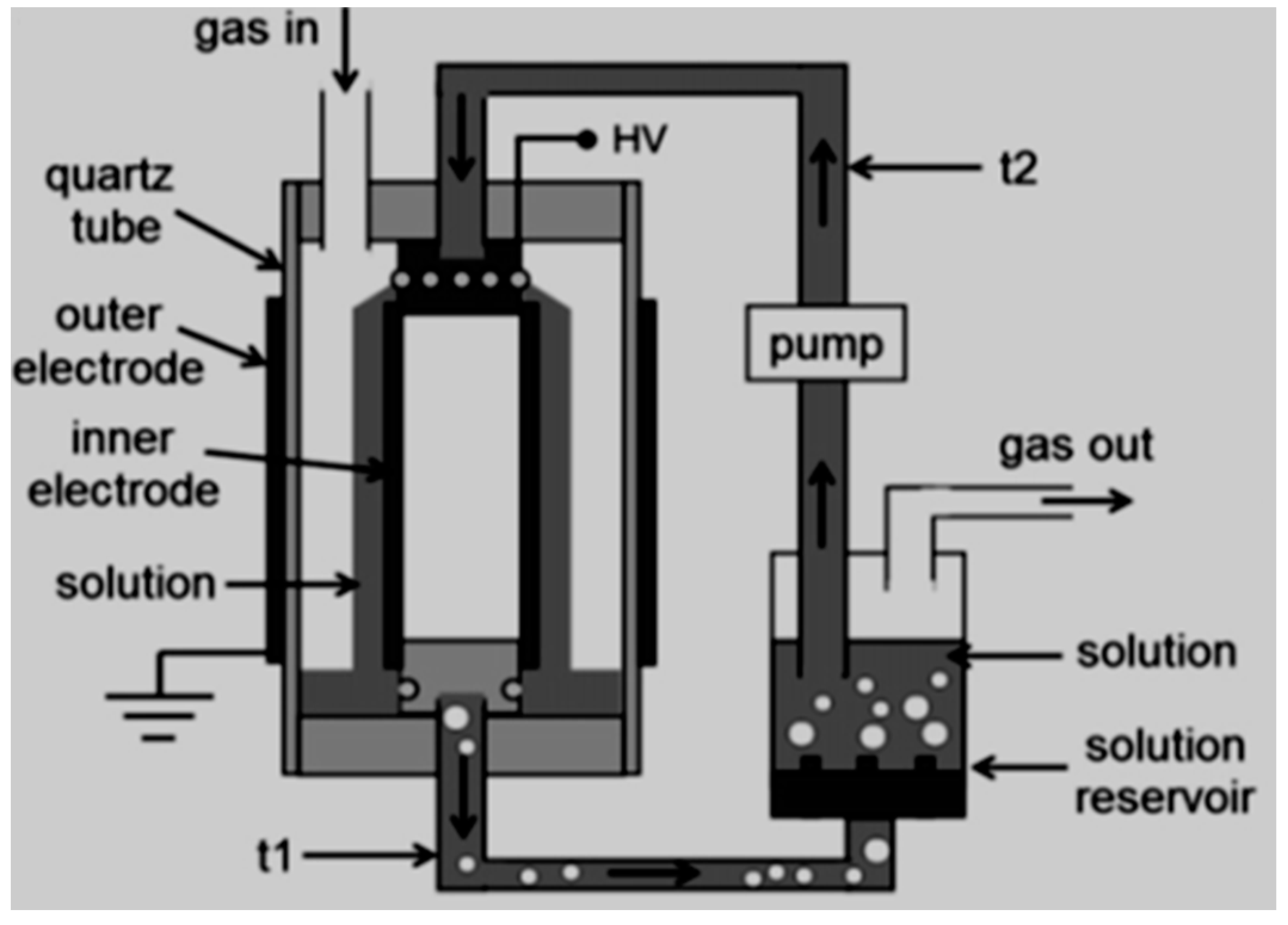
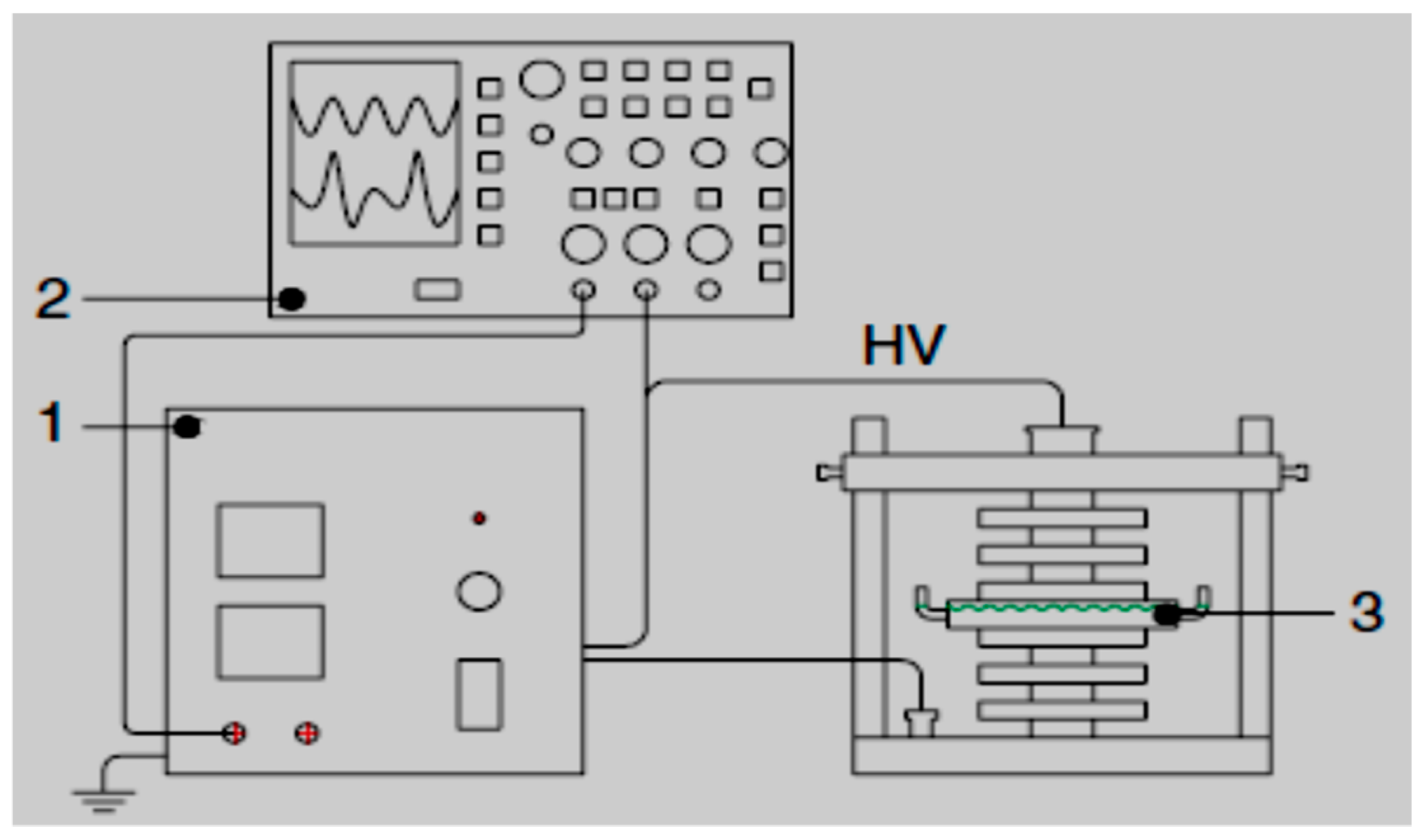
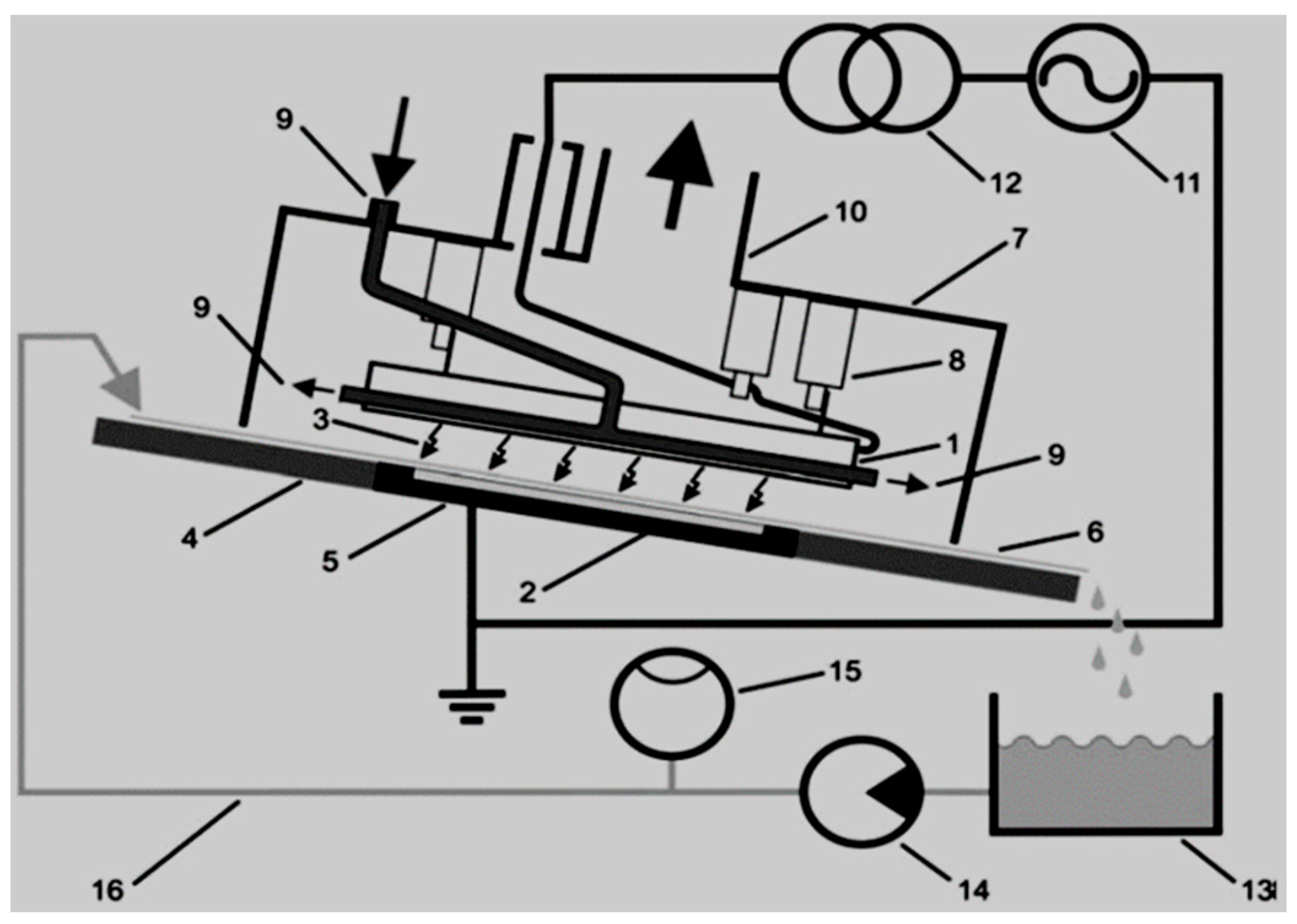
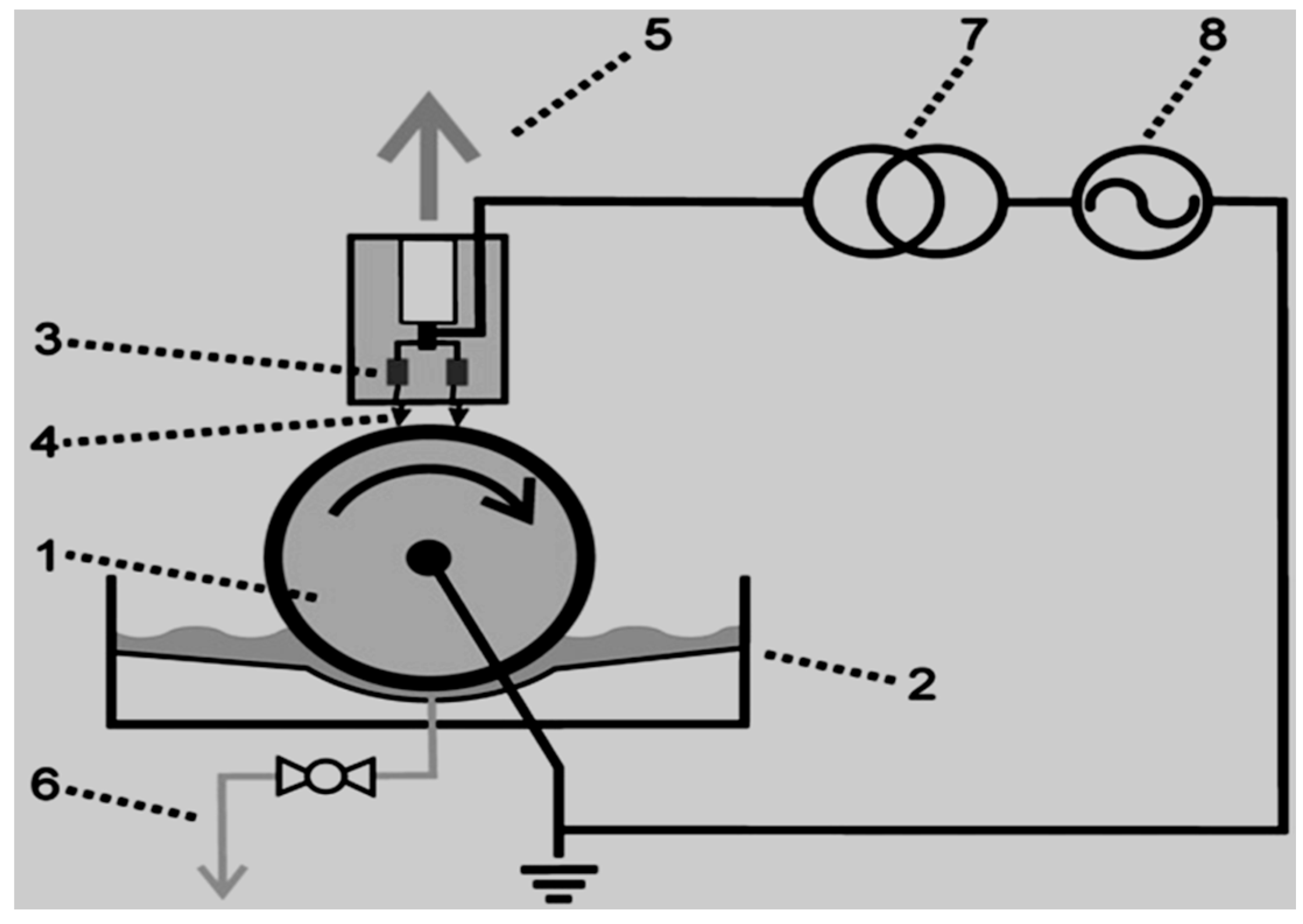
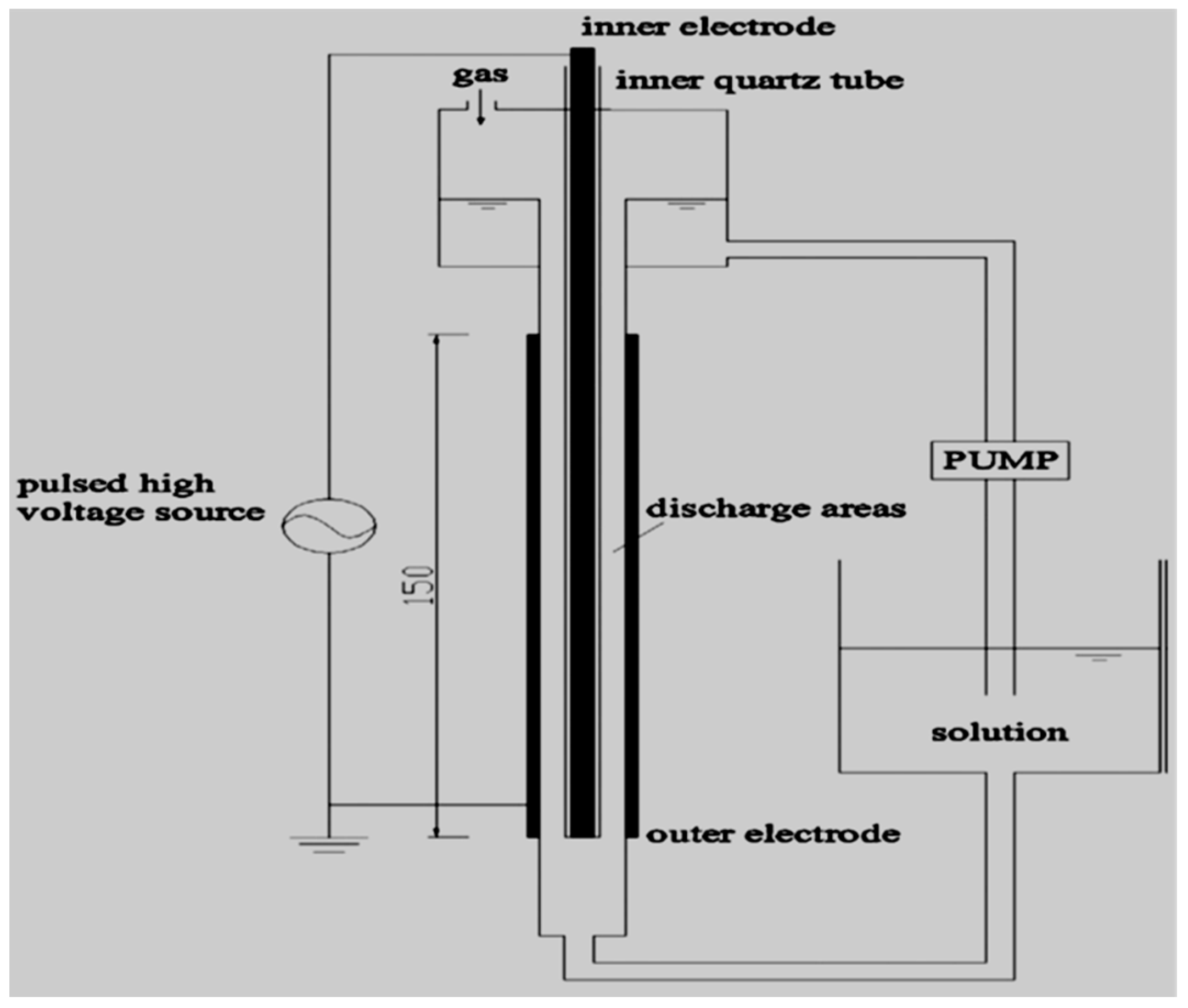
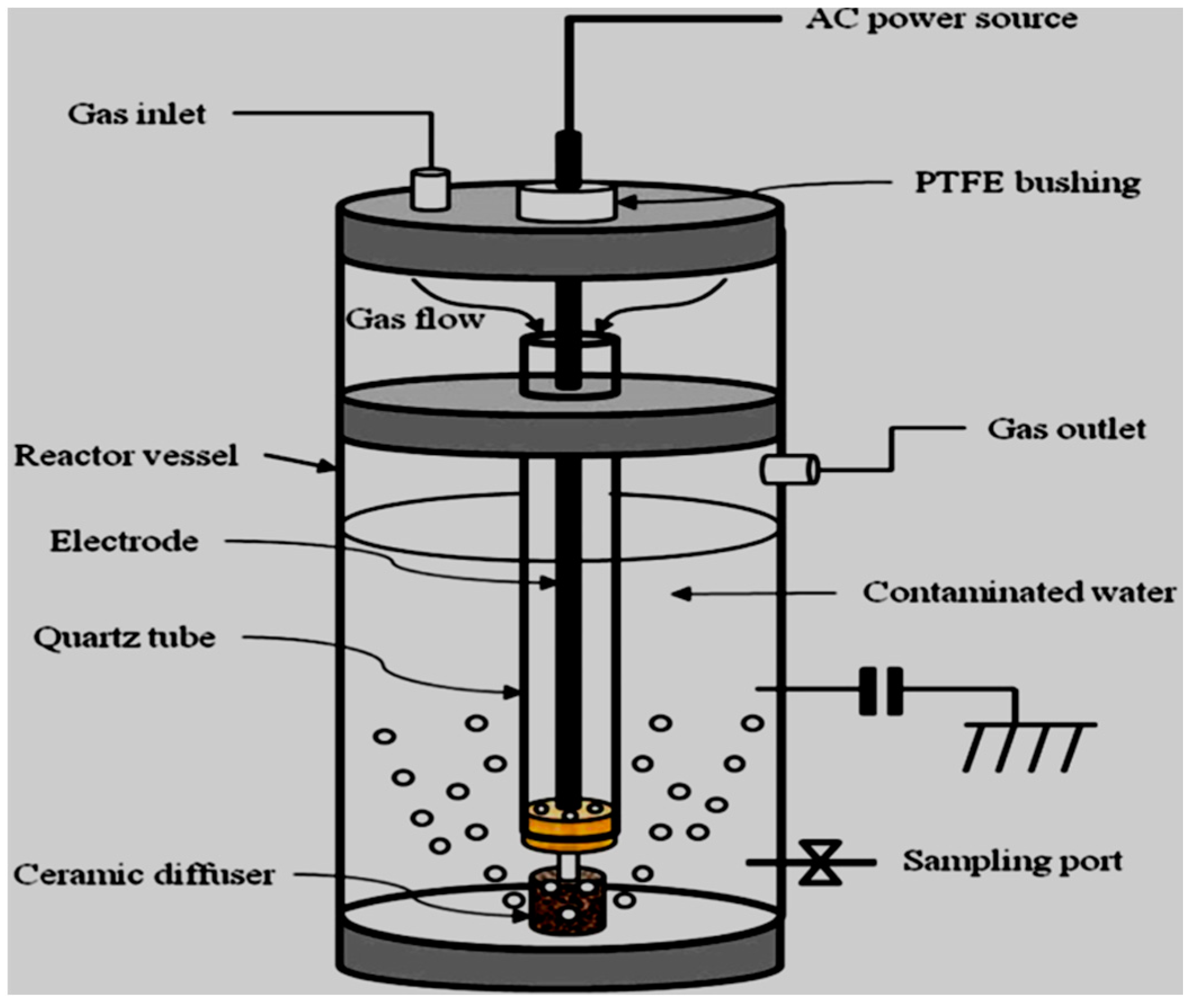
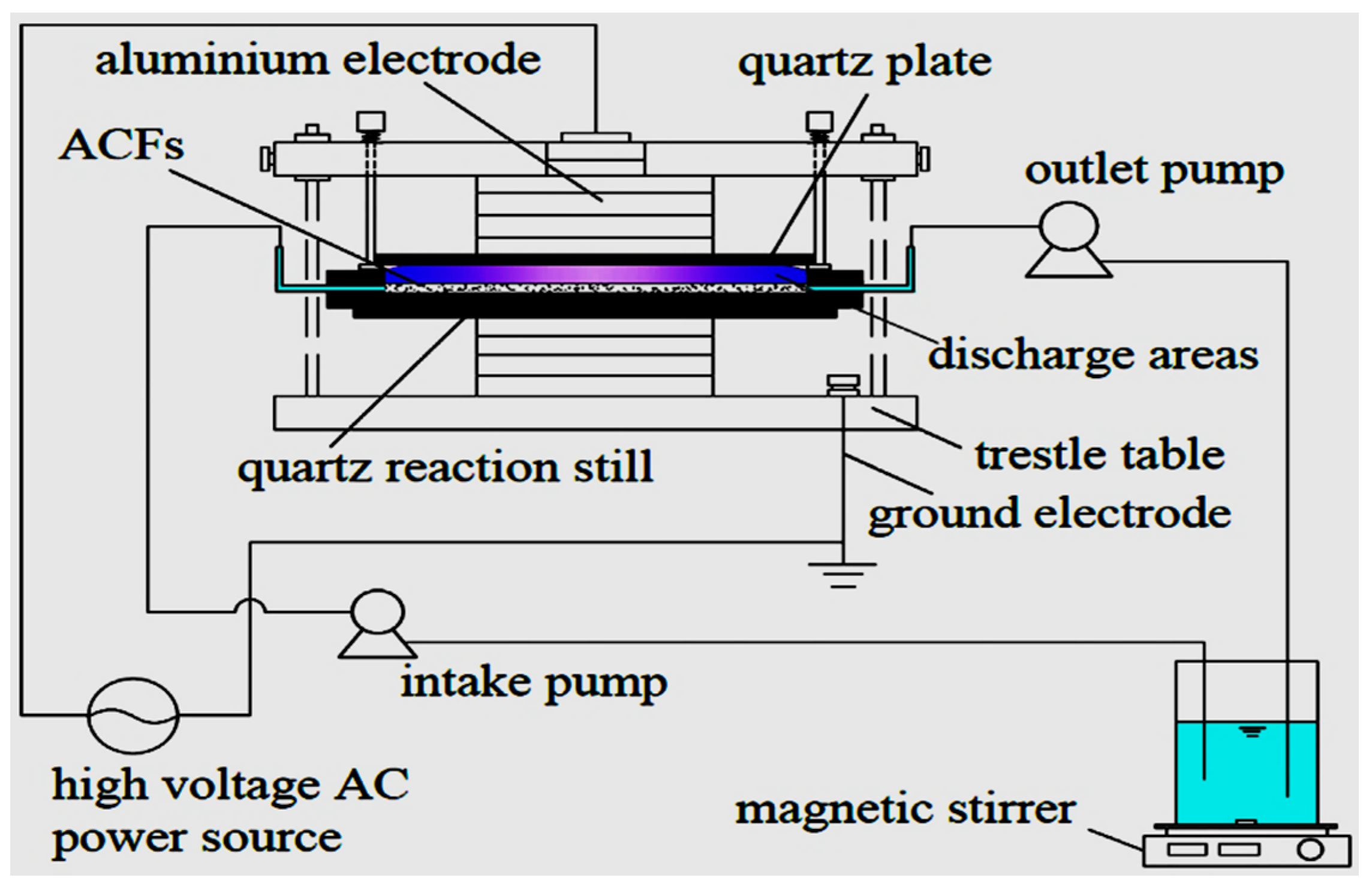
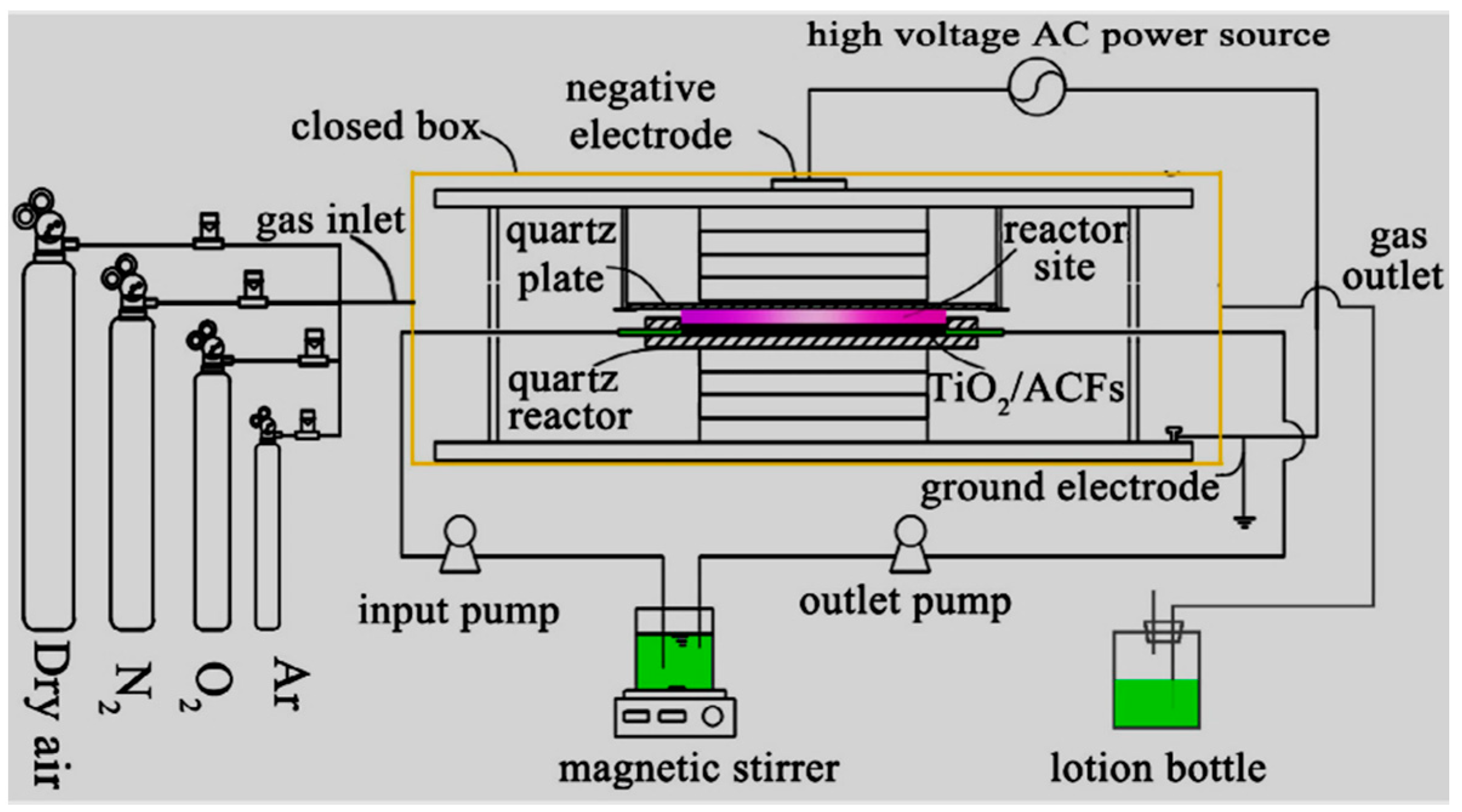
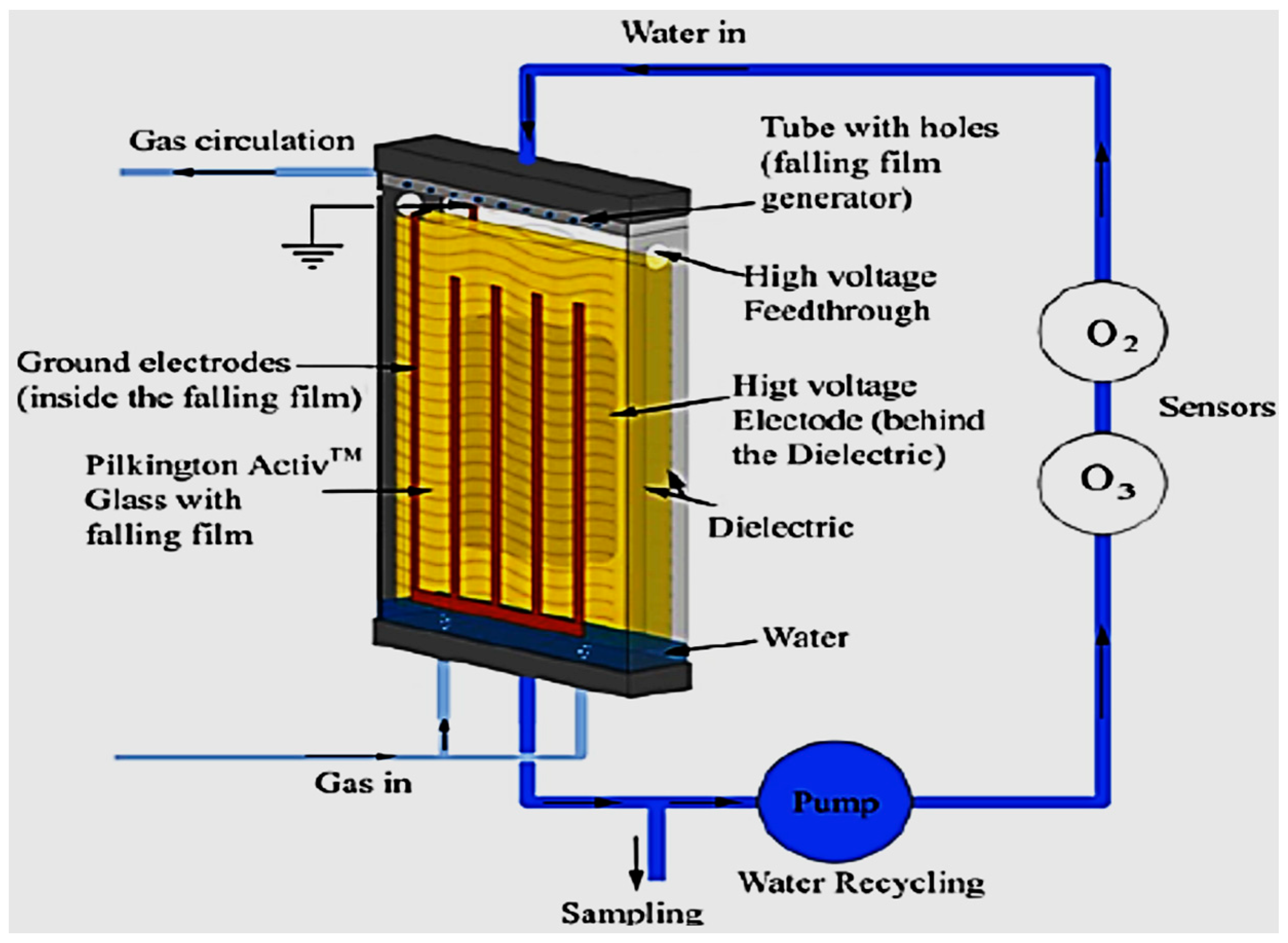
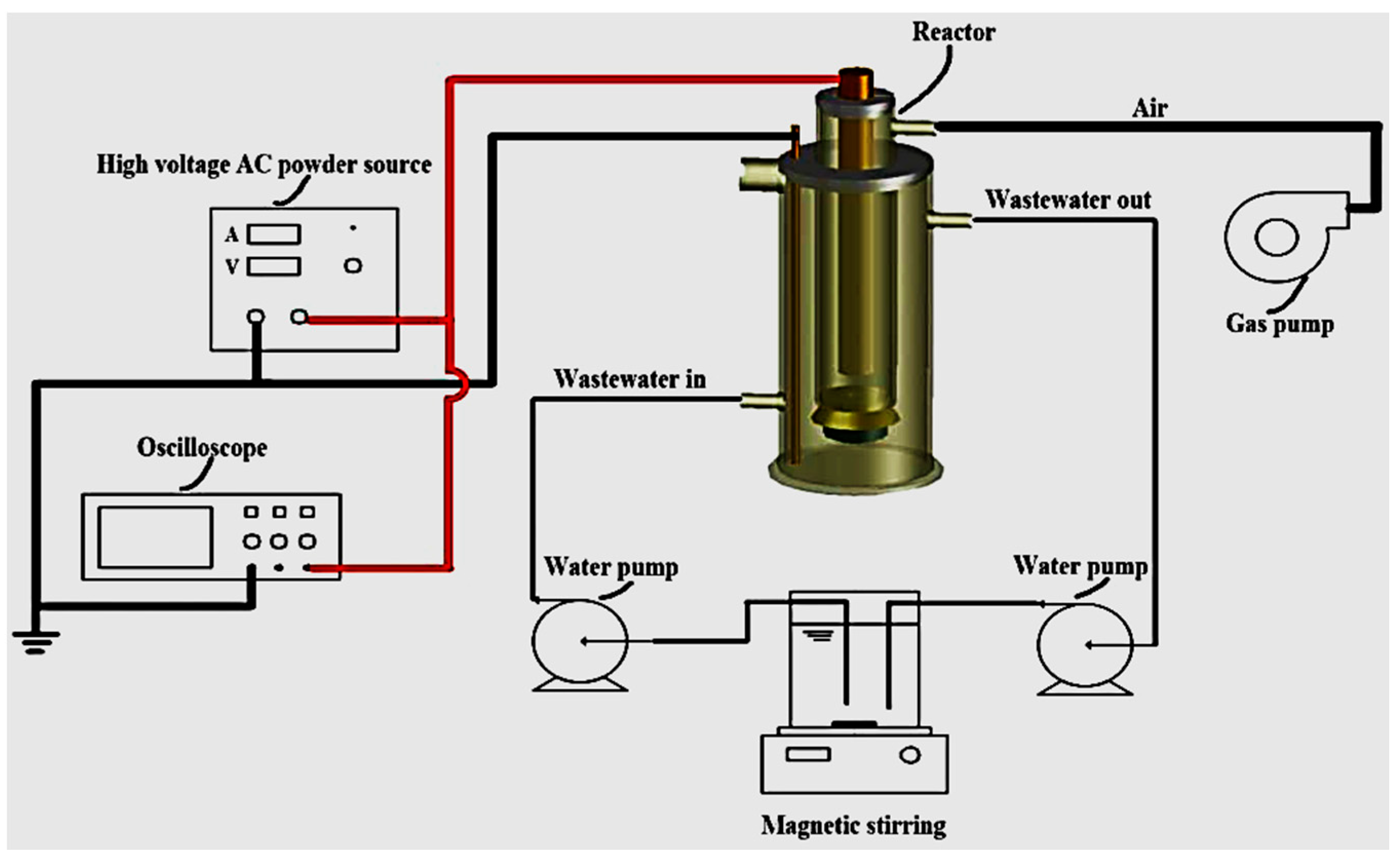
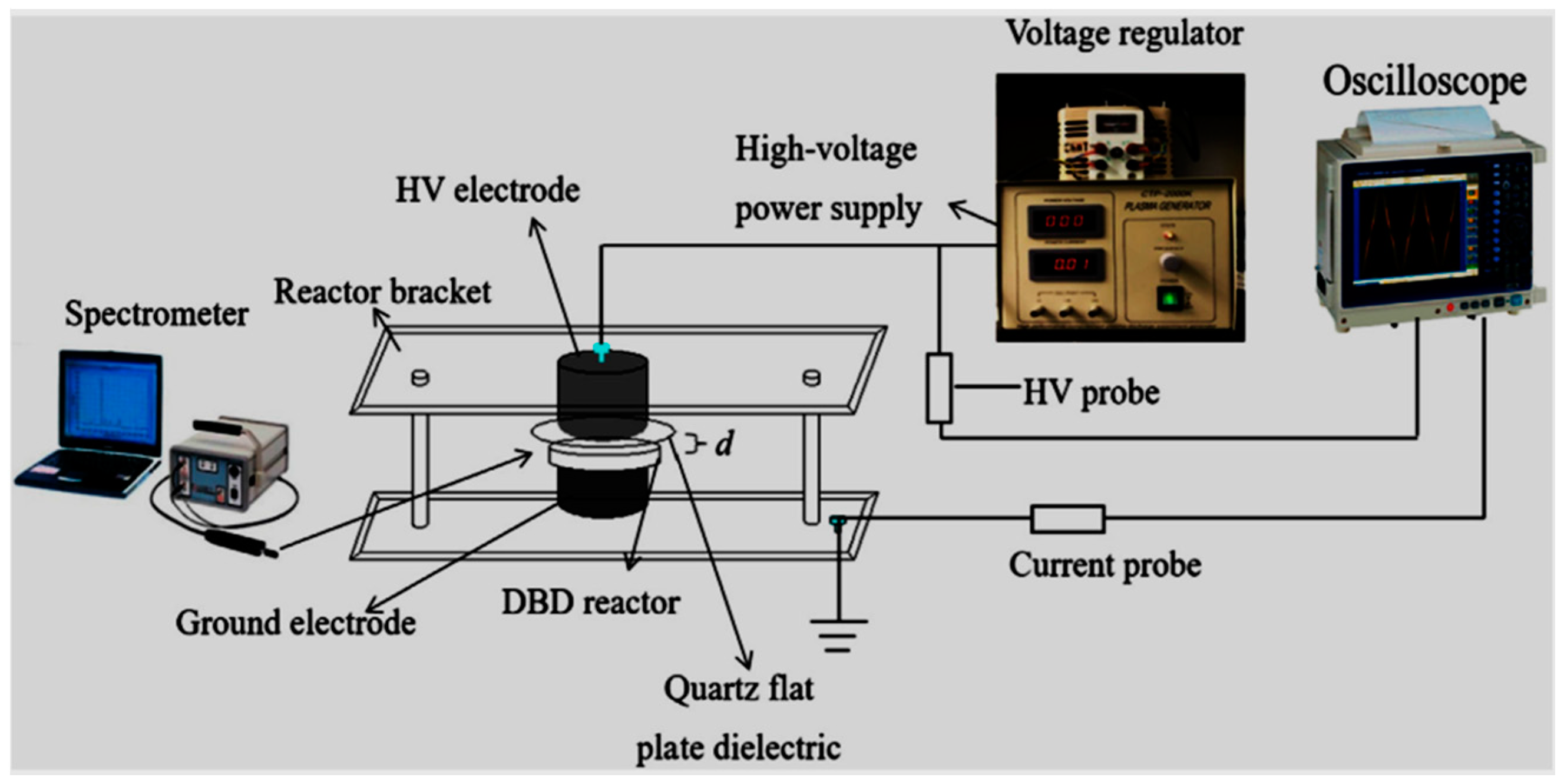
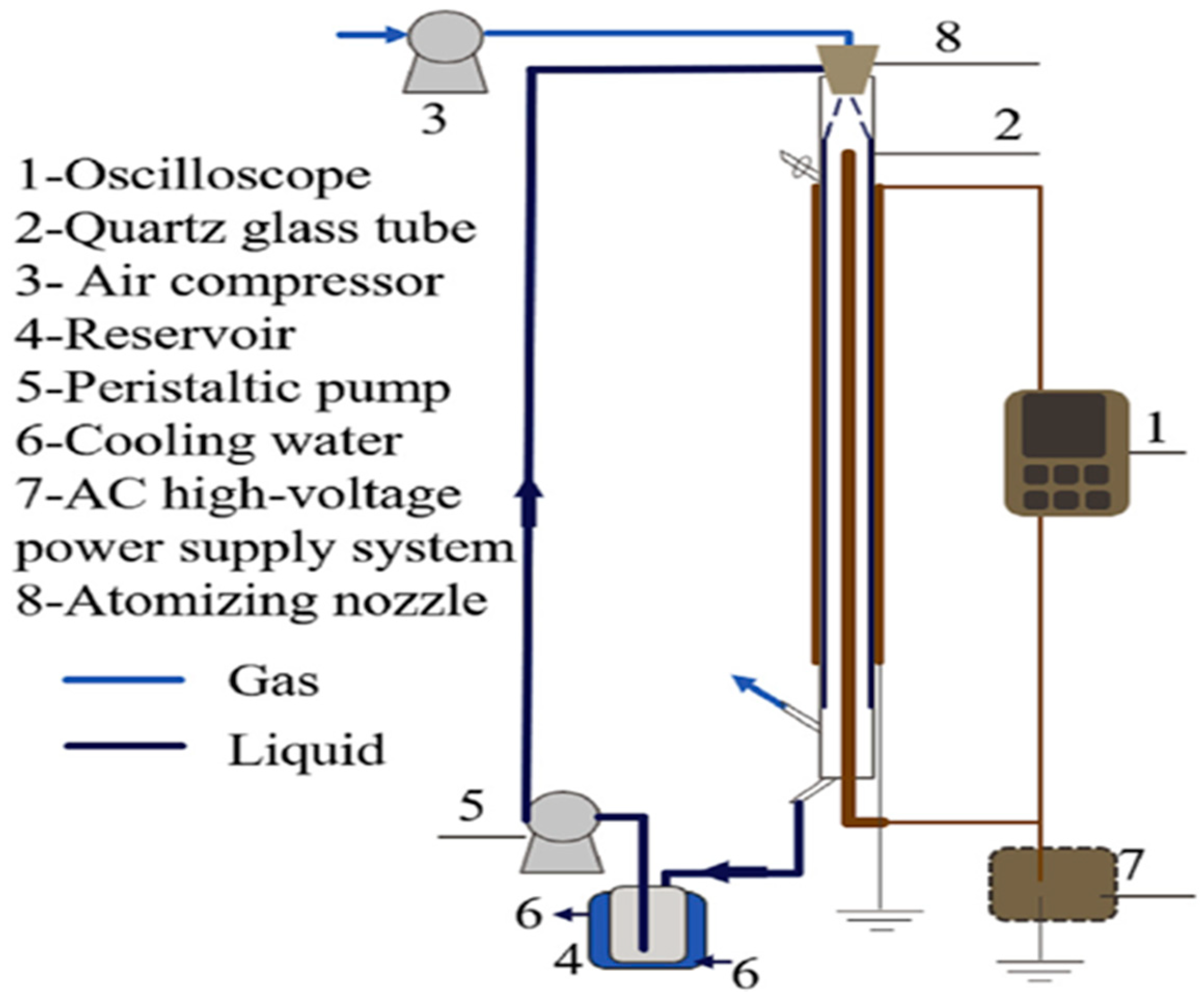
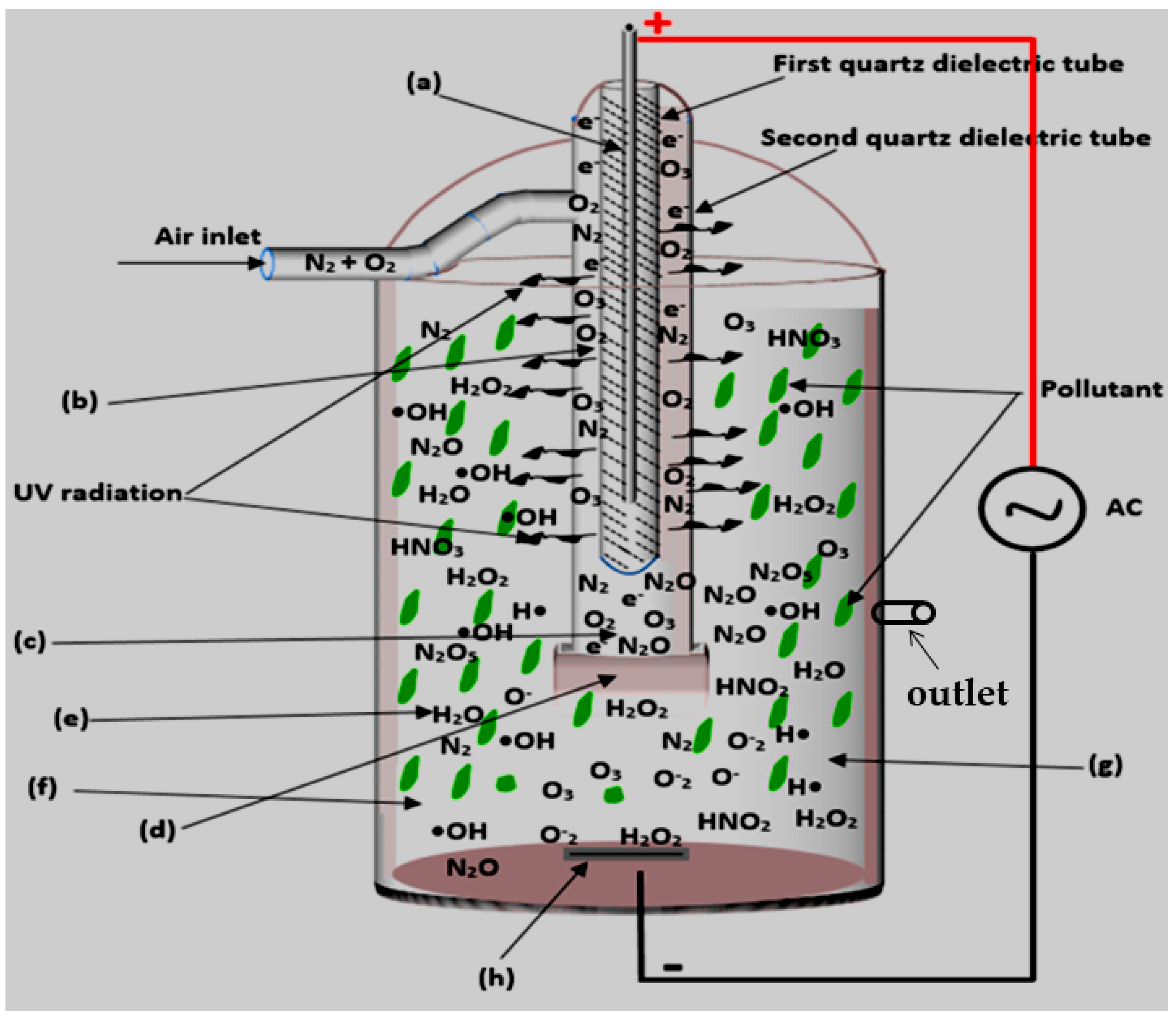
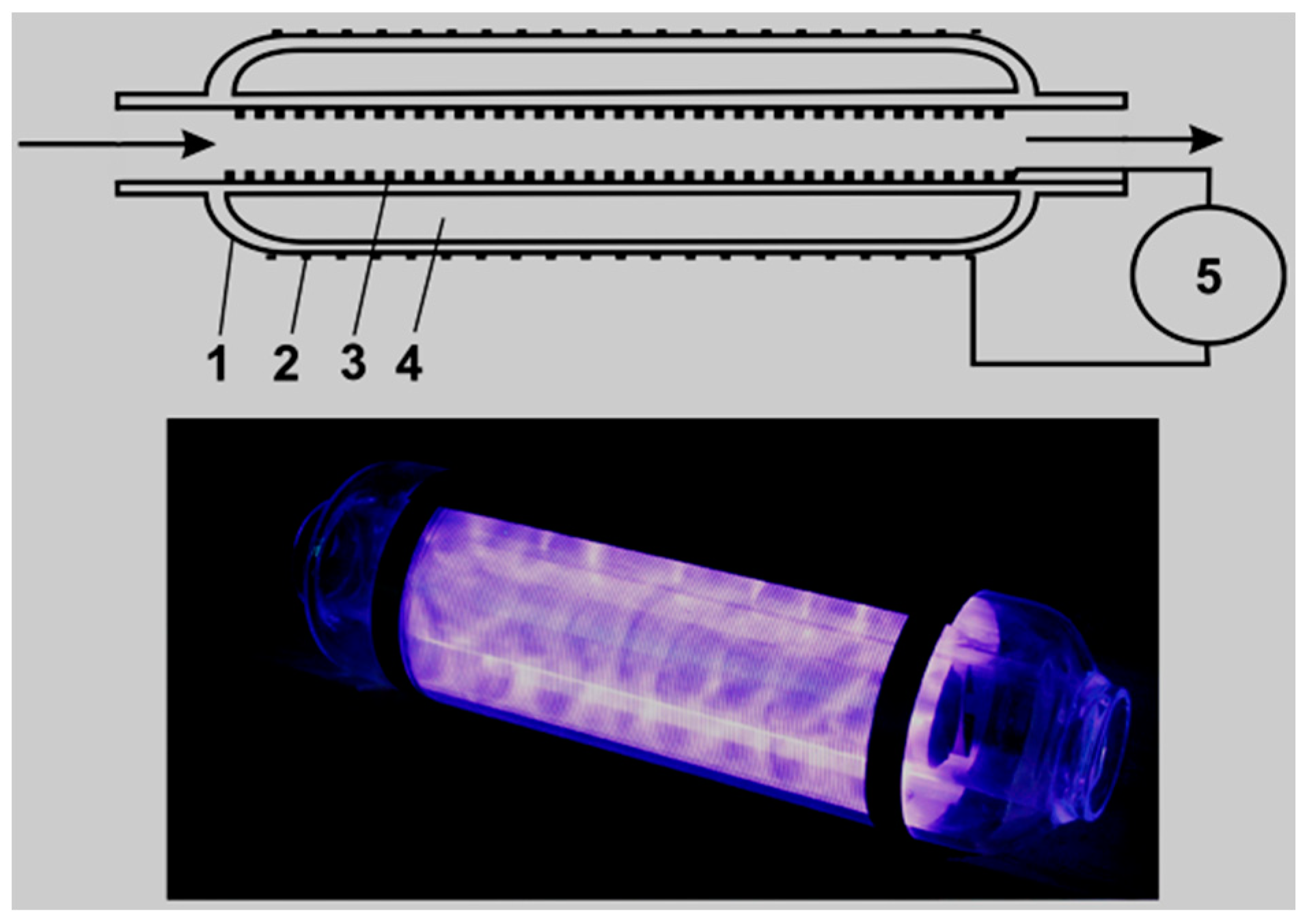

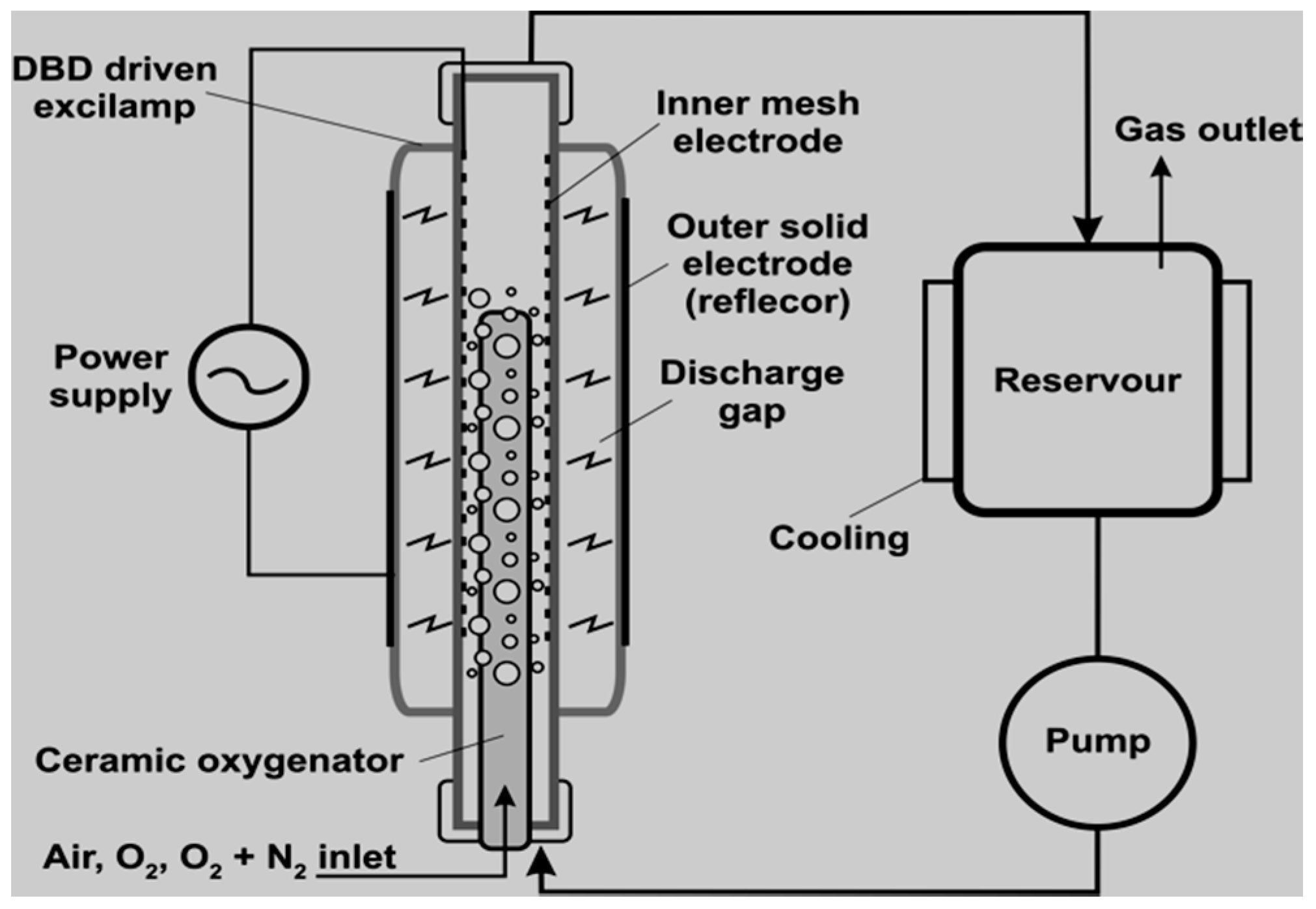
| Africa | Countries | Types of Pharmaceuticals | Pharmaceutical Compounds | Concentration | Sources | References |
| South Africa, (Kwazulu-Natal) | Antipyretics, antibiotics, lipid regulators, antipsychotic anti-epileptic drug | Aspirin nalidixic acid, caffeine, bezafibrate, clozapine | 0.82–118 mg/L | Msunduzi river, wastewater | [68,69] | |
| Enugu, South-East Nigeria | Antibiotics, oestrogens, lipid-lowering drugs, non-steroidal anti-inflammatory drugs | Diclofenac | 8.84–1100 µg/L | Wastewater treatment plants | [67] | |
| Chirapatre Estates in Kumasi, Ghana | Paracetamol | NA | Irrigation water | [66] | ||
| Asia | South China | PPCPs, synthetic steroid oestrogens, endocrine-disrupting phenols, acidic pharmaceuticals | Nonylphenol, bisphenol A, triclosan, 2-phenyl phenol, methylparaben, propylparaben, salicylic acid, clofibric acid, Ibuprofen | 65 ng/L–1417 ng/L | Urbane rivers of the Pearl River delta | [79] |
| China (Beijing) | Antibiotics, antilipidemic, anti-inflammatory, antihypertensive, anticonvulsant, stimulant, insect repellent, antipsychotic | Caffeine, N, N-Diethyl-meta-toluamide (DEET) | 2.2–320 ng/L | WWTPs | [80] | |
| China | Antibiotics, anti-inflammatories, lipid regulators | Carbamazepine, caffeine, N, N-diethyl –m-toluamide | BLD-6 to 35.31 ng/L | Groundwater | [81] | |
| Yang pu district, China | Antibiotics, analgesics, antiepileptics, lipid regulators | Caffein, paracetamol, propranolol, azithromycin, clarithromycin | 100–857 ng/L | Urban rivers | [82] | |
| Japan | Veterinary drugs and antibiotics | Amantadine, carbamazepine, epinastine, ibuprofen, iopamidol, oseltamivir acid | NA | Finished drinking water | [83] | |
| India | Antipsychoactive, antihypertensive, antimicrobials, analgesics, stimulants | Carbamazepine, atenolol, triclocarban, caffeine, ciprofloxacin, enoxacin, ketoprofen, erythromycin, naproxen, diclofenac, enrofloxacin | NA | Conventional activated sludge WWTPs, hospital WTPs, rivers, and groundwater. | [63] | |
| South Korea | Antibiotics, hormones, antihypertensive, stimulants | Acetaminophen, atenolol, lincomycin, hormones, antihypertensive, antiepileptic | ˃10 µg/L | WWTPs, sewage effluent | [84] | |
| Malaysia | NSAIDs, stimulants | Caffeine and diclofenac | Non-detected-54 ng/L | Langat and Muar Rivers | [85] | |
| North & Central America | Countries | Types of pharmaceuticals | Pharmaceutical compounds | Concentration | Sources | References |
| Mexico | Antibiotics, non-steroidal anti-inflammatory drugs | Acetaminophen, atenolol, carbamazepine, clarithromycin, diclofenac, ibuprofen | 0.01–6800 ng/L | Sewage effluent, aquaculture | [86] | |
| USA, Pennsylvania | Pharmaceutical compounds, hormones, organic wastewater compounds (OWCs) | Acetaminophen, caffeine, carbamazepine, tylosin, sulfadimethoxine, sulfamethoxazole, oxytetracycline | 24–1340 ng/L | Pennsylvania Waters | [64] | |
| USA, Georgia | Pharmaceuticals and personal products (PPCPs): Antibiotics, analgesics, anti-inflammatory, diuretics, antipyretics, antihypertension, fragrances, flame retardants, disinfectants, antiseptics, and pesticides | Acetylsalicylic acid, 17-Ethinylestradiol, dimethylaminophenazone, hydrocodone, Cashmeran, biphenylol, Tetrabromobisphenol A | 0.0002–230 µg/L | Wastewater treatment plant (WWTP) influents | [87,88] | |
| USA, North Carolina | Pharmaceuticals: Antibiotics, analgesics, diuretics, antipyretics, anti-inflammatory, antihypertension | Acetaminophen, caffeine, tylosin, carbamazepine, sulfadimethoxine, sulfamethoxazole, oxytetracycline, | ˃ppb | Wastewater treatment plant (WWTP) effluents | [89] | |
| USA, Liberty Bay, Puget Sound, Washington | Herbicides and pharmaceutical and personal care products (PPCPs) and flame retardants | N, N-diethyl-meta-toluamide, caffeine, and mecoprop | NA | Surface Water and Groundwater in WWTPs | [90] | |
| USA, Southern Nevada | Contaminants of emerging concern | Naproxen, gemfibrozil, atenolol | ˃1 μg/L | Municipal wastewater effluents and marine receiving water | [65] | |
| South America | Argentina | Analgesics, anti-inflammatories anticonvulsant, Stimulants | Carbamazepine, caffeine and ibuprofen | 0.03–4.2 μg/L | Wastewater effluents | [91] |
| Brazil | Lipid regulators, anti-inflammatories | Bezafibrate, gemfibrozil, ibuprofen, diclofenac | 0.1 to 0.5 μg/L | Effluents of sewage treatment plants (STPs) | [92] | |
| Colombia | Antibiotics, anticonvulsants, non-steroidal anti-inflammatory drugs | Acetaminophen paracetamol, carbamazepine diclofenac, ibuprofen | NA | Wastewaters effluent and influent surface waters | [93] | |
| Europe | Countries | Types of pharmaceuticals | Pharmaceutical compounds | Concentration | Sources | References |
| Finland | Antibiotics, antiepileptic, anti-inflammatories | Ciprofloxacin, norfloxacin and ofloxacin carbamazepine diclofenac, ibuprofen, ketoprofen, naproxen | NA | Sewage Treatment Plants effluents, Surface Waters | [94] | |
| France | Psychostimulants, non-steroidal anti-inflammatory drugs, iodinated contrast media, and anxiolytic drugs | Ciprofloxacin, norfloxacin and ofloxacin carbamazepine diclofenac, ibuprofen, ketoprofen, naproxen | NA | Surface water | [55] | |
| Germany | Antibiotics | Penicillins, carbamazepine, clofibric acid, iopromide | NA | Sewage treatment plant (STP) discharges, groundwater, Wastewater and household waste | [95] | |
| Italy | Antibiotics, anti-inflammatory | Propranolol, paracetamol | 0.001 to 284 ug/L | NA | [60] | |
| Netherland | Antibiotics, anticonvulsants | Carbamazepine, erythromycin | 0.31–0.90 ug/L | Sewage Treatment Plants effluents, surface water | [96] | |
| Portugal | Antibiotics, anticonvulsants, anti-inflammatory | Ibuprofen, sulfamethoxazole, ketoprofen, carbamazepine, fluoxetine | NA | Influents and effluents of two wastewater treatment plants | [97] | |
| Romania | Antibiotics, anticonvulsants, anti-inflammatory | Sulfamethoxazole, diclofenac, carbamazepine, trimethoprim, thiabendazole, clotrimazole | 5 to 50 ng/ L | Rivers | [98] | |
| Serbia | Antibiotics, anticonvulsants, anti-inflammatory | Sulfamethoxazole, carbamazepine, trimethoprim | NA | River sediments, surface, and groundwater | [62] | |
| Spain | Anti-inflammatories, antidepressant | Ketoprofen, naproxen, fluoxetine | 0.3–324.7 ng/L | Wastewater treatment plants discharges | [99] | |
| Switzerland | Antibiotics, anti-inflammatories | Diclofenac, carbamazepine | NA | Wastewater, groundwater | [100] | |
| Turkey | Antibiotics, anticonvulsants, anti-inflammatory | Acetaminophen, carbamazepine, hospital wastewater | up to 160 µg/L | Sewage-treatment plant discharges | [61] | |
| United Kingdom | Sewage treatment plants and wastewater | Ibuprofen and ciprofloxacin | NA | Sewage treatment plant (STP) discharges, Groundwater | [101] |
| Penicillin-Type Antibiotics | Anti-Inflammatory Drugs /NSAIDS | Beta-Blockers/ Antihypertensive | Steroids and Hormones | Lipid Regulators | Anticonvulsants/Antiepileptic | Antidepressants | Cancer Therapeutics |
|---|---|---|---|---|---|---|---|
| Amoxicillin | Acetaminophen | Atenolol | Diethylstibestrol | Bezafibrate | Carbamazepine | Diazepam | Cyclophosphamide |
| Ampicillin | Aspirin (acetylsalicylic acid) | Betaxolol | Diethylstibestrol acetate | Clofibric acid | Dilantin | Furosemide | Ifosfamide |
| Chlortetracycline | Diclofenac | Diltiazem | 17-α-ethinyl estradiol | Fenofibrate | Phenobarbital | Fluoxetine | |
| Ciprofloxacin | Codeine | Enalapril | 17-β-estradiol estrone | Gemfibrozil | Primidone | Meprobamate | |
| Erythromycin | Ibuprofen | Furosemide | Estrone | Paroxetine | |||
| Flumequine | Indomethacin | Losartan | Mestranol | ||||
| Lincomycin | Metamizole | Metoprolol | |||||
| Penicillin | Naproxen | Nadolol | |||||
| Ofloxacin | Phenazone | Propranolol | |||||
| Oxacillin | Sotalol | ||||||
| Oxytetracycline | |||||||
| Spiramycin | |||||||
| Streptomycin | |||||||
| Sulfamethoxazole | |||||||
| Trimethoprim |
| Pharmaceutical Compounds | Wastewater Source | Initial Concentration (mg/L) | pH | DBD Reactor Configuration and Process Design | Treatment Scale | Treatment Time (min) | Degradation % | Energy (mol/J) | Intermediates | References |
|---|---|---|---|---|---|---|---|---|---|---|
| sulfadiazine antibiotics | Synthetic wastewater | 10 | 9 | Water falling film DBD | Laboratory scale | 30 | 87 | 38.6 × 10−12 | Yes | [157] |
| Veterinary antibiotics | Synthetic wastewater | 5 | NA | Single cylindrical DBD plasma reactor | Laboratory scale | 30 | 60–90 | NA | Yes | [159] |
| carbamazepine | Synthetic wastewater | 20 | NA | Ex situ DBD system | Laboratory scale | 60 | 81–90 | NA | Yes | [156] |
| atrazine | Synthetic wastewater | 0.03 | 5.06 | Atmospheric pulsed DBD | Laboratory scale | 45 | 61 | NA | Yes | [175] |
| 17b-estradiol | Synthetic wastewater | 0.4 | 5.6 | non-thermal plasma (DBD) | Laboratory scale | 30 | 72.0 | NA | Yes | [176] |
| pentoxifylline | Synthetic wastewater | 100 | 7 | DBD coaxial reactor configuration | Laboratory scale | 60 | 92.5 | NA | Yes | [155] |
| Three b-lactam antibiotics | Synthetic wastewater | 100 | NA | DBD coaxial reactor configuration | Laboratory scale | 10–30 | 25–30% of TC | NA | Yes | [158] |
| (Atrazine, chlorfenvinfos, 2,4-dibromophenol, and lindane) | Synthetic wastewater | 1–5 | NA | Batch reactor (R1) and Coaxial reactor (R2) | Laboratory scale | 15 | 86.6–98.0 (R1) and 40.3–93.6 (R2) | NA | Yes | [177] |
| iopromide | Synthetic wastewater | 17 | NA | DBD | Laboratory scale | 10 | 99 | 0.14 × 10−9 | NA | [178] |
| enalapril | Synthetic wastewater | 50 | NA | DBD with falling liquid film | Laboratory scale | 120 | 99.4 | 2 × 10−9 | Yes | [179] |
| carbamazepine | Synthetic wastewater | 20 | NA | DBD with falling liquid film | Laboratory scale | 60 | 90.7 | 0.18 × 10−9 | Yes | [156] |
| carbamazepi | Synthetic wastewater | 23.6 | NA | DBD rotating drum reactor | Laboratory scale | 60 | 94 | 52.2 × 10-12 | NA | [162] |
| iopromide | Synthetic wastewater | 79.1 | NA | DBD rotating drum reactor | Laboratory scale | 60 | 98 | 54.4 × 10−12 | [162] | |
| clofibric acid | Synthetic wastewater | 21.5 | NA | DBD rotating drum reactor | Laboratory scale | 30 | 100 | 0.11 × 10−9 | [162] | |
| amoxicillin | Synthetic wastewater | 100 | NA | DBD with falling liquid film | Laboratory scale | 10 | 100 | 79.8 × 10−9 | Yes | [158] |
| ampicillin | Synthetic wastewater | 100 | NA | DBD with falling liquid film | Laboratory scale | 30 | 100 | 23.1 × 10−9 | Yes | [158] |
| oxacillin | Synthetic wastewater | 100 | NA | DBD with falling liquid film | Laboratory scale | 30 | 100 | 18.7 × 10−9 | Yes | [158] |
| pentoxifylline | Synthetic wastewater | 100 | NA | DBD with falling liquid film | Laboratory scale | 60 | 92 | 16 × 10−9 | yes | [155] |
| carbamazepine | Synthetic wastewater | 23.6 | NA | DBD | Laboratory scale | 30 | 98 | 21.7 × 10−12 | [161] | |
| clofibric acid | Synthetic wastewater | 21.5 | NA | DBD | Laboratory scale | 30 | 100 | 22.3 × 10−12 | NA | [161] |
| iopromide | Synthetic wastewater | 79.1 | NA | DBD | Laboratory scale | 30 | 99 | 22 × 10−12 | NA | [161] |
| Pharmaceutical Compounds | Initial Concentration (mg/L) | Treatment Time (min) | DBD Reactor Configuration and Process Design | Power (w) | Rate Constant kr (min−1) | Half-Life Time t1/2 (min) | Energy Yield (G50) (g/KWh) | References |
|---|---|---|---|---|---|---|---|---|
| Sulfadiazine antibiotics | 10 | 30 | Water falling film DBD | 150 | 6.8 × 10−2 | 10.19 | 19.60 | [157] |
| Veterinary antibiotics | 5 | 30 | Single cylindrical DBD plasma reactor | 8.9 | 3.05 ×10−2 | 22.72 | 12.16–12.14 | [159] |
| Carbamazepine | 20 | 60 | Ex situ DBD system | 0.7–12 | 2.76 × 10−2–3.8 × 10−2 | 25.10–18.23 | 308.70–18.01 | [156] |
| Atrazine | 0.03 | 45 | Atmospheric pulsed DBD | 1.7 | 2.09 × 10−1 | 3.31 | 0.17 | [175] |
| 17b-estradiol | 0.4 | 30 | Non-thermal plasma (DBD) | NA | 4.24 × 10−2 | 16.34 | NA | [176] |
| Pentoxifylline | 100 | 60 | DBD coaxial reactor configuration | 1 | 4.32 × 10−2 | 16.04 | 2220.29 | [155] |
| Three b-lactam antibiotics | 100 | 10–30 | DBD coaxial reactor configuration | 2 | 9.7 × 10−3 | 71.44 | 1820.88–2206.49 | [158] |
| (Atrazine, Chlorfenvinfos, 2,4-dibromophenol, and lindane) | 1–5 | 15 | Batch reactor (R1) and Coaxial reactor (R2) | 30 | 1.34 × 10−1–2.6 ×10−1 | 5.17–2.66 | 2.741–12.95 | [177] |
| Iopromide | 17 | 10 | DBD | NA | 4.6 ×10−1 | 1.50 | NA | [178] |
| Enalapril | 50 | 120 | DBD with falling liquid film | NA | 4.26 × 10−2 | 16.26 | 34.6 | [179] |
| Carbamazepine | 20 | 60 | DBD with falling liquid film | 0.7–12 | 3.95 × 10−2 | 17.54 | 310.40–18.10 | [156] |
| Carbamazepine | 23.6 | 60 | DBD rotating drum reactor | 250–750 | 4.68 × 10−2 | 14.81 | 10.65–3.55 | [162] |
| Iopromide | 79.1 | 60 | DBD rotating drum reactor | 250–750 | 6.5 × 10−2 | 10.66 | 37.22–12.41 | [162] |
| Clofibric acid | 21.5 | 30 | DBD rotating drum reactor | 250–750 | 3.32 × 10−1 | 2.08 | 20.44–6.81 | [162] |
| Amoxicillin | 100 | 10 | DBD with falling liquid film | 2 | 0.115 × 101 | 0.60 | 7213.23 | [158] |
| Ampicillin | 100 | 30 | DBD with falling liquid film | 2 | 3.83 × 10−1 | 1.80 | 2379.30 | [158] |
| Oxacillin | 100 | 30 | DBD with falling liquid film | 2 | 3.83 × 10−1 | 1.80 | 2381.12 | [158] |
| Pentoxifylline | 100 | 60 | DBD with falling liquid film | 1 | 4.2 × 10−2 | 16.5 | 2208.03 | [155] |
| Carbamazepine | 23.6 | 30 | DBD | 250–500 | 1.3 × 10−1 | 5.33 | 4.44–2.22 | [161] |
| Clofibric acid | 21.5 | 30 | DBD | 250–500 | 3.32 × 10−1 | 2.08 | 4.10–2.05 | [161] |
| Iopromide | 79.1 | 30 | DBD | 250–500 | 1.53 × 10−1 | 4.52 | 15.04–7.52 | [161] |
Publisher’s Note: MDPI stays neutral with regard to jurisdictional claims in published maps and institutional affiliations. |
© 2021 by the authors. Licensee MDPI, Basel, Switzerland. This article is an open access article distributed under the terms and conditions of the Creative Commons Attribution (CC BY) license (http://creativecommons.org/licenses/by/4.0/).
Share and Cite
Massima Mouele, E.S.; Tijani, J.O.; Badmus, K.O.; Pereao, O.; Babajide, O.; Zhang, C.; Shao, T.; Sosnin, E.; Tarasenko, V.; Fatoba, O.O.; et al. Removal of Pharmaceutical Residues from Water and Wastewater Using Dielectric Barrier Discharge Methods—A Review. Int. J. Environ. Res. Public Health 2021, 18, 1683. https://doi.org/10.3390/ijerph18041683
Massima Mouele ES, Tijani JO, Badmus KO, Pereao O, Babajide O, Zhang C, Shao T, Sosnin E, Tarasenko V, Fatoba OO, et al. Removal of Pharmaceutical Residues from Water and Wastewater Using Dielectric Barrier Discharge Methods—A Review. International Journal of Environmental Research and Public Health. 2021; 18(4):1683. https://doi.org/10.3390/ijerph18041683
Chicago/Turabian StyleMassima Mouele, Emile S., Jimoh O. Tijani, Kassim O. Badmus, Omoniyi Pereao, Omotola Babajide, Cheng Zhang, Tao Shao, Eduard Sosnin, Victor Tarasenko, Ojo O. Fatoba, and et al. 2021. "Removal of Pharmaceutical Residues from Water and Wastewater Using Dielectric Barrier Discharge Methods—A Review" International Journal of Environmental Research and Public Health 18, no. 4: 1683. https://doi.org/10.3390/ijerph18041683
APA StyleMassima Mouele, E. S., Tijani, J. O., Badmus, K. O., Pereao, O., Babajide, O., Zhang, C., Shao, T., Sosnin, E., Tarasenko, V., Fatoba, O. O., Laatikainen, K., & Petrik, L. F. (2021). Removal of Pharmaceutical Residues from Water and Wastewater Using Dielectric Barrier Discharge Methods—A Review. International Journal of Environmental Research and Public Health, 18(4), 1683. https://doi.org/10.3390/ijerph18041683









